Delta 36-978, 36-979 User Manual

|
36-978 |
|
36-979 |
|
10" Contractors Saw |
|
(Model 36-978/36-979) |
10” (254 mm) Left |
|
Tilt CONTRACTOR’S |
|
SAW® |
|
CONTRACTOR’S |
|
SAW® - Sierra para |
|
constructores de |
|
254 mm (10 pulg) |
|
inclinable a la |
|
izquierda |
|
Scie d’entrepreneur |
Shown with optional Beisemeyer Fence |
|
|
CONTRACTOR’S |
Instruction Manual |
SAWMD de 254 mm |
|
(10 po) avec |
Manuel d’Utilisation |
inclinaison à |
Manual de Instrucciones |
gauche |
|
|
ESPAÑOL (37) FRANÇAIS (73) |
|
www.deltamachinery.com |
|
(800) 223-7278 - US |
A18825 - 08-29-06 |
(800) 463-3582 - CANADA |
|
|
Copyright © 2006 Delta Machinery |
|

TABLE OF CONTENTS
IMPORTANT SAFETY INSTRUCTIONS . . . . . . . . . . . . . . . . . . . . . . . . . . . . . . . . . . . . . . . . . . . . . . . . . . . . . . . . . . . 2 SAFETY GUIDELINES. . . . . . . . . . . . . . . . . . . . . . . . . . . . . . . . . . . . . . . . . . . . . . . . . . . . . . . . . . . . . . . . . . . . . . . . . 3 TOOL WARNING LABELS . . . . . . . . . . . . . . . . . . . . . . . . . . . . . . . . . . . . . . . . . . . . . . . . . . . . . . . . . . . . . . . . . . . . . 3 GENERAL SAFETY RULES . . . . . . . . . . . . . . . . . . . . . . . . . . . . . . . . . . . . . . . . . . . . . . . . . . . . . . . . . . . . . . . . . . . . 4 ADDITIONAL SPECIFIC SAFETY RULES . . . . . . . . . . . . . . . . . . . . . . . . . . . . . . . . . . . . . . . . . . . . . . . . . . . . . . . . . 5 FUNCTIONAL DESCRIPTION . . . . . . . . . . . . . . . . . . . . . . . . . . . . . . . . . . . . . . . . . . . . . . . . . . . . . . . . . . . . . . . . . . 8 CARTON CONTENTS . . . . . . . . . . . . . . . . . . . . . . . . . . . . . . . . . . . . . . . . . . . . . . . . . . . . . . . . . . . . . . . . . . . . . . . . 8 ASSEMBLY . . . . . . . . . . . . . . . . . . . . . . . . . . . . . . . . . . . . . . . . . . . . . . . . . . . . . . . . . . . . . . . . . . . . . . . . . . . . . . . . 10 OPERATION . . . . . . . . . . . . . . . . . . . . . . . . . . . . . . . . . . . . . . . . . . . . . . . . . . . . . . . . . . . . . . . . . . . . . . . . . . . . . . . 19 TROUBLESHOOTING . . . . . . . . . . . . . . . . . . . . . . . . . . . . . . . . . . . . . . . . . . . . . . . . . . . . . . . . . . . . . . . . . . . . . . . . 31 MAINTENANCE. . . . . . . . . . . . . . . . . . . . . . . . . . . . . . . . . . . . . . . . . . . . . . . . . . . . . . . . . . . . . . . . . . . . . . . . . . . . . 33 SERVICE . . . . . . . . . . . . . . . . . . . . . . . . . . . . . . . . . . . . . . . . . . . . . . . . . . . . . . . . . . . . . . . . . . . . . . . . . . . . . . . . . . 34 ACCESSORIES . . . . . . . . . . . . . . . . . . . . . . . . . . . . . . . . . . . . . . . . . . . . . . . . . . . . . . . . . . . . . . . . . . . . . . . . . . . . . 34 WARRANTY. . . . . . . . . . . . . . . . . . . . . . . . . . . . . . . . . . . . . . . . . . . . . . . . . . . . . . . . . . . . . . . . . . . . . . . . . . . . . . . . 34 FRANÇAIS . . . . . . . . . . . . . . . . . . . . . . . . . . . . . . . . . . . . . . . . . . . . . . . . . . . . . . . . . . . . . . . . . . . . . . . . . . . . . . . . . 35 ESPAÑOL. . . . . . . . . . . . . . . . . . . . . . . . . . . . . . . . . . . . . . . . . . . . . . . . . . . . . . . . . . . . . . . . . . . . . . . . . . . . . . . . . . 67
IMPORTANT SAFETY INSTRUCTIONS
 Read and understand all warnings and operating instructions before using any tool or equipment. Always follow basic safety precautions to reduce the risk of personal injury. Improper operation, maintenance, or modification of tools or equipment could result in serious injury and property damage. Our tools and equipment are designed for certain applications. DO NOT modify and/or use this product for any application other than for which it was designed.
Read and understand all warnings and operating instructions before using any tool or equipment. Always follow basic safety precautions to reduce the risk of personal injury. Improper operation, maintenance, or modification of tools or equipment could result in serious injury and property damage. Our tools and equipment are designed for certain applications. DO NOT modify and/or use this product for any application other than for which it was designed.
If you have any questions relative to its application, DO NOT use the product until you have contacted Delta Machinery and we have advised you.
Online contact form at www.deltamachinery.com
Postal Mail: Technical Service Manager
Delta Machinery
4825 Highway 45 North Jackson, TN 38305
(IN CANADA: 125 Mural St. Suite 300, Richmond Hill, ON, L4B 1M4)
Information regarding the safe and proper operation of this tool is available from the following sources:
Power Tool Institute
1300 Sumner Avenue, Cleveland, OH 44115-2851 www.powertoolinstitute.org
National Safety Council
1121 Spring Lake Drive, Itasca, IL 60143-3201
American National Standards Institute, 25 West 43rd Street, 4 floor, New York, NY 10036 www.ansi.org ANSI 01.1Safety Requirements for Woodworking Machines, and
The U.S. Department of Labor regulations www.osha.gov
SAVE THESE INSTRUCTIONS!
2
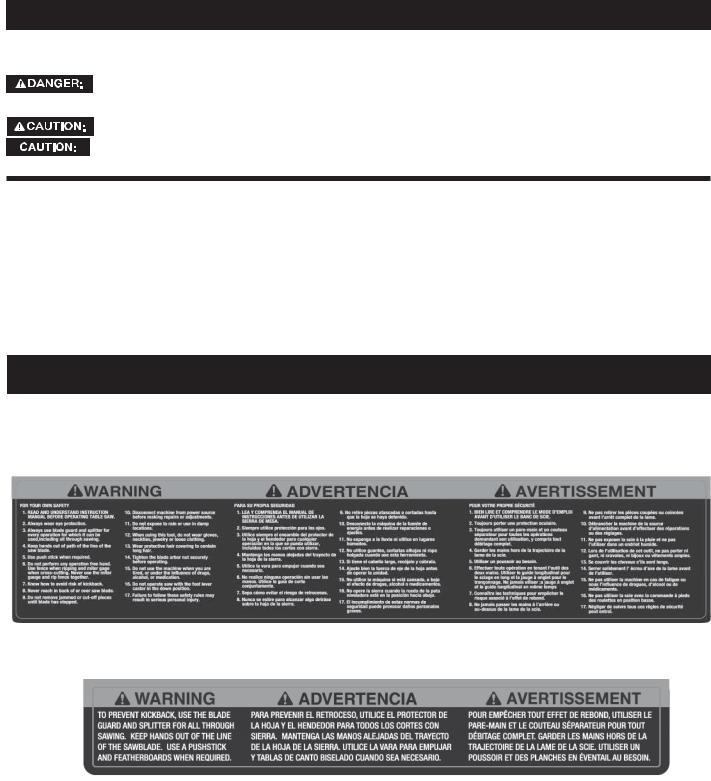
SAFETY GUIDELINES
It is important for you to read and understand this manual. The information it contains relates to protecting YOUR SAFETY and PREVENTING PROBLEMS. The symbols below are used to help you recognize this information.
Indicates an imminently hazardous situation which, if not avoided, will result in death or serious injury.


 Indicates a potentially hazardous situation which, if not avoided, could result in death or serious injury. Indicates a potentially hazardous situation which, if not avoided, may result in minor or moderate injury.
Indicates a potentially hazardous situation which, if not avoided, could result in death or serious injury. Indicates a potentially hazardous situation which, if not avoided, may result in minor or moderate injury.
Used without the safety alert symbol indicates potentially hazardous situation which, if not avoided, may result in property damage.
CALIFORNIA PROPOSITION 65
 SOME DUST CREATED BY POWER SANDING, SAWING, GRINDING, DRILLING, AND OTHER CONSTRUCTION ACTIVITIES contains chemicals known to cause cancer, birth defects or other reproductive harm. Some examples of these chemicals are:
SOME DUST CREATED BY POWER SANDING, SAWING, GRINDING, DRILLING, AND OTHER CONSTRUCTION ACTIVITIES contains chemicals known to cause cancer, birth defects or other reproductive harm. Some examples of these chemicals are:
·lead from lead-based paints,
·crystalline silica from bricks and cement and other masonry products, and
·arsenic and chromium from chemically-treated lumber.
Your risk from these exposures varies, depending on how often you do this type of work. To reduce your exposure to these chemicals: work in a well ventilated area, and work with approved safety equipment, always wear NIOSH/OSHA approved, properly fitting face mask or respirator when using such tools.
TOOL WARNING LABELS
Before use, read the warning labels located on the saw. Also read any warning labels that are included with the fence installed on the saw. If the warning labels identified below are illegible or missing from the saw, contact Delta Customer Service for free replacements. (The contact information is listed in the "SERVICE" section of this manual.)
3

GENERAL SAFETY RULES
 READ AND UNDERSTAND ALL WARNINGS AND OPERATING INSTRUCTIONS BEFORE USING THIS EQUIPMENT. Failure to follow all instructions listed below, may result in electric shock, fire, and/or serious personal injury or property damage.
READ AND UNDERSTAND ALL WARNINGS AND OPERATING INSTRUCTIONS BEFORE USING THIS EQUIPMENT. Failure to follow all instructions listed below, may result in electric shock, fire, and/or serious personal injury or property damage.
IMPORTANT SAFETY INSTRUCTIONS
1.FOR YOUR OWN SAFETY, READ THE INSTRUCTION MANUAL BEFORE OPERATING THE MACHINE. Learning the machine’s application, limitations, and specific hazards will greatly minimize the possibility of accidents and injury.
2.WEAR EYE AND HEARING PROTECTION. ALWAYS USE SAFETY GLASSES. Everyday eyeglasses are NOT safety glasses. USE CERTIFIED SAFETY EQUIPMENT. Eye protection equipment should comply with ANSI Z87.1 standards. Hearing equipment should comply with ANSI S3.19 standards.
3.WEAR PROPER APPAREL. Do not wear loose clothing, gloves, neckties, rings, bracelets, or other jewelry which may get caught in moving parts. Nonslip protective footwear is recommended. Wear protective hair covering to contain long hair.
4.DO NOT USE THE MACHINE IN A DANGEROUS ENVIRONMENT. The use of power tools in damp or wet locations or in rain can cause shock or electrocution. Keep your work area well-lit to prevent tripping or placing arms, hands, and fingers in danger.
5.MAINTAIN ALL TOOLS AND MACHINES IN PEAK CONDITION. Keep tools sharp and clean for best and safest performance. Follow instructions for lubricating and changing accessories. Poorly maintained tools and machines can further damage the tool or machine and/or cause injury.
6.CHECK FOR DAMAGED PARTS. Before using the machine, check for any damaged parts. Check for alignment of moving parts, binding of moving parts, breakage of parts, and any other conditions that may affect its operation. A guard or any other part that is damaged should be properly repaired or replaced with Delta or factory authorized replacement parts. Damaged parts can cause further damage to the machine and/or injury.
7.KEEP THE WORK AREA CLEAN. Cluttered areas and benches invite accidents.
8.KEEP CHILDREN AND VISITORS AWAY. Your shop is a potentially dangerous environment. Children and visitors can be injured.
9.REDUCE THE RISK OF UNINTENTIONAL STARTING. Make sure that the switch is in the “OFF” position before plugging in the power cord. In the event of a power failure, move the switch to the “OFF” position. An accidental start-up can cause injury. Do not touch the plug’s metal prongs when unplugging or plugging in the cord.
10.USE THE GUARDS. Check to see that all guards are in place, secured, and working correctly to prevent injury.
11.REMOVE ADJUSTING KEYS AND WRENCHES BEFORE STARTING THE MACHINE. Tools, scrap pieces, and other debris can be thrown at high speed, causing injury.
12.USE THE RIGHT MACHINE. Don’t force a machine or an attachment to do a job for which it was not designed. Damage to the machine and/or injury may result.
13.USE RECOMMENDED ACCESSORIES. The use of accessories and attachments not recommended by Delta may cause damage to the machine or injury to the user.
14.USE THE PROPER EXTENSION CORD. Make sure your extension cord is in good condition. When using an extension cord, be sure to use one heavy enough to carry the current your product will draw. An undersized cord will cause a drop in line voltage, resulting in loss of power and overheating. See the Extension Cord Chart for the correct size depending on the cord length and nameplate ampere rating. If in doubt, use the next heavier gauge. The smaller the gauge number, the heavier the cord.
15.SECURE THE WORKPIECE. Use clamps or a vise to hold the workpiece when practical. Loss of control of a workpiece can cause injury.
16.FEED THE WORKPIECE AGAINST THE DIRECTION OF THE ROTATION OF THE BLADE, CUTTER, OR ABRASIVE SURFACE. Feeding it from the other direction will cause the workpiece to be thrown out at high speed.
17.DON’T FORCE THE WORKPIECE ON THE MACHINE.
Damage to the machine and/or injury may result.
18.DON’T OVERREACH. Loss of balance can make you fall into a working machine, causing injury.
19.NEVER STAND ON THE MACHINE. Injury could occur if the tool tips, or if you accidentally contact the cutting tool.
20.NEVER LEAVE THE MACHINE RUNNING UNATTENDED. TURN THE POWER OFF. Don’t leave the machine until it comes to a complete stop. A child or visitor could be injured.
21.TURN THE MACHINE “OFF”, AND DISCONNECT THE MACHINE FROM THE POWER SOURCE before installing or removing accessories, changing cutters, adjusting or changing set-ups. When making repairs, be sure to lock the start switch in the “OFF” position. An accidental startup can cause injury.
22.MAKE YOUR WORKSHOP CHILDPROOF WITH PADLOCKS, MASTER SWITCHES, OR BY REMOVING STARTER KEYS. The accidental start-up of a machine by a child or visitor could cause injury.
23. STAY ALERT, WATCH WHAT YOU ARE DOING, AND
USE COMMON SENSE. DO NOT USE THE MACHINE WHEN YOU ARE TIRED OR UNDER THE INFLUENCE OF DRUGS, ALCOHOL, OR MEDICATION. A moment of inattention while operating power tools may result in injury.
24.  USE OF THIS TOOL CAN GENERATE
USE OF THIS TOOL CAN GENERATE
AND DISBURSE DUST OR OTHER AIRBORNE PARTICLES, INCLUDING WOOD DUST, CRYSTALLINE SILICA DUST AND ASBESTOS DUST. Direct particles away from face and body. Always operate tool in well ventilated area and provide for proper dust removal. Use dust collection system wherever possible. Exposure to the dust may cause serious and permanent respiratory or other injury, including silicosis (a serious lung disease), cancer, and death. Avoid breathing the dust, and avoid prolonged contact with dust. Allowing dust to get into your mouth or eyes, or lay on your skin may promote absorption of harmful material. Always use properly fitting NIOSH/OSHA approved respiratory protection appropriate for the dust exposure, and wash exposed areas with soap and water.
4

ADDITIONAL SPECIFIC SAFETY RULES
 FAILURE TO FOLLOW THESE RULES MAY RESULT IN SERIOUS PERSONAL INJURY.
FAILURE TO FOLLOW THESE RULES MAY RESULT IN SERIOUS PERSONAL INJURY.
1. DO NOT OPERATE THIS MACHINE until it is assembled and installed according to the instructions.
2.OBTAIN ADVICE FROM YOUR SUPERVISOR, instructor, or another qualified person if you are not familiar with the operation of this machine.
3.FOLLOW ALL WIRING CODES and recommended electrical connections.
4.ALWAYS USE GUARDS, SPLITTER, AND ANTI-KICKBACK PAWLS whenever possible, including through sawing. Check to see that they are in place, secured and working correctly. Test the anti-kickback pawl action before ripping by pushing the wood under the anti-kickback teeth. The teeth must prevent the wood from being thrown toward the front of the saw.
5.CUTTING THE WORKPIECE WITHOUT THE USE OF A FENCE OR MITER GAUGE IS KNOWN AS “FREEHAND” CUTTING. NEVER perform “free-hand” operations. Use either the fence or miter gauge to position and guide the workpiece.
6.HOLD THE WORKPIECE FIRMLY against the miter gauge or fence.
7.CUTTING COMPLETELY THROUGH THE WORK-PIECE IS KNOWN AS “THROUGH-SAWING”. Ripping and crosscutting are through-sawing operations. Cutting with the grain is ripping. Use a fence or fence system for ripping. NEVER use a miter gauge for ripping. Use push sticks for ripping a narrow workpiece. Cutting across the grain is crosscutting. Never use a fence or fence system for cross-cutting. Instead, use a miter gauge.
8.KICKBACK IS THE NATURAL TENDENCY OF THE WORKPIECE TO BE THROWN BACK AT THE OPERATOR when the workpiece initially contacts the blade or if the workpiece pinches the blade. Kickback is dangerous and can result in serious injury.
AVOID KICKBACK by:
A.keeping blade sharp and free of rust and pitch.
B.keeping rip fence parallel to the saw blade.
C.using saw blade guard and splitter for every possible operation, including all through sawing.
D.keeping splitter aligned with sawblade.
E.keeping the anti-kickback pawls in place and sharpened.
F.pushing the workpiece past the saw blade prior to release.
G.never ripping a workpiece that is twisted or warped, or does not have a straight edge to guide along the fence.
H.using featherboards when the anti-kickback device or the guard and splitter cannot be used.
I.never sawing a large workpiece that cannot be controlled.
J.never using the fence as a guide when crosscutting.
K.never sawing a workpiece with loose knots, flaws, nails or other foreign objects.
L.never ripping a workpiece shorter than 10”.
 SOME MATERIALS ARE TOO HARD AND SLIPPERY FOR THE ANTI-KICKBACK PAWLS TO BE EFFECTIVE. Plastic and compositions (like hardboard) may be cut on your saw, but be especially attentive to following proper set-up and cutting procedures to prevent any kickbacks when cutting these materials.
SOME MATERIALS ARE TOO HARD AND SLIPPERY FOR THE ANTI-KICKBACK PAWLS TO BE EFFECTIVE. Plastic and compositions (like hardboard) may be cut on your saw, but be especially attentive to following proper set-up and cutting procedures to prevent any kickbacks when cutting these materials.
9.USE THE CORRECT SAWBLADE FOR THE INTENDED OPERATION. The blade must rotate toward the front of the saw. Always tighten the blade arbor nut securely. Before use, inspect the blade for cracks or missing teeth. Do not use a damaged blade.
10.NEVER USE ABRASIVE WHEELS on this saw.
11.DO NOT CUT METAL WITH THIS SAW.
12.REMOVE CUT-OFF PIECES AND SCRAPS from the table before starting the saw. The vibration of the machine may cause them to move into the saw blade and be thrown out.
13.CUT-OFF PIECES CAN BE THROWN BACK AT THE OPERATOR. For large cut-off pieces, use a push stick to push the piece past the blade and off the back of the saw table. Do not reach across sawblade. Be careful that small pieces do not contact the blade.
14.NEVER ATTEMPT TO FREE A STALLED SAW BLADE WITHOUT FIRST TURNING THE MACHINE OFF. If a workpiece or cut-off piece becomes trapped inside the guard, turn saw off and wait for blade to stop before lifting the guard and removing the piece.
15.NEVER START THE MACHINE with the workpiece against the blade.
16.NEVER run the workpiece between the fence and a moulding cutterhead.
17.KEEP ARMS, HANDS, AND FINGERS away from the blade. Use a push stick to push small workpieces through the saw. A push stick is a small wooden stick, usually homemade, that should be used whenever the size or shape of the workpiece would cause you to place your hands within six inches of the blade. See “CONSTRUCTING A PUSH STICK” in the back of this manual for guidance on making your own.
18.AVOID AWKWARD OPERATIONS AND HAND POSITIONS where a sudden slip could cause a hand to move into the blade.
19.NEVER have any part of your body in line with the path of the saw blade.
20.NEVER REACH AROUND or over the saw blade.
21.PROPERLY SUPPORT LONG (3 feet or longer) OR WIDE (36” or wider) WORKPIECES. If extension tables wider than 24” are attached to the saw, bolt the saw stand to the floor, or use a sturdy outrigger support to prevent tipping.
22.PREVENT MOTION OF THE SAW WHILE IN USE. If the mobility kit is installed, lower the foot pedal and level the feet so the saw does not rock, walk, slide or tip. If necessary, secure the stand to the floor.
23.NEVER PERFORM LAYOUT, assembly or set-up work on the table/work area when the machine is running.
24.TURN THE MACHINE “OFF” AND DISCONNECT THE MACHINE from the power source before installing or removing accessories, changing the sawblade, or adjusting or changing set-ups. Lock switch in the “OFF” position when making repairs.
25.CLEAN THE TABLE/WORK AREA BEFORE LEAVING THE MACHINE. Lock the switch in the “OFF” position to prevent unauthorized use.
26.ADDITIONAL INFORMATION regarding the safe and proper operation of power tools (i.e. a safety video) is available from the Power Tool Institute, 1300 Sumner Avenue, Cleveland, OH 44115-2851 (www.powertoolinstitute.com). Information is also available from the National Safety Council, 1121 Spring Lake Drive, Itasca, IL 60143-3201. Please refer to the American National Standards Institute ANSI 01.1 Safety Requirements for Woodworking Machines and the U.S. Department of Labor OSHA 1910.213 Regulations.
SAVE THESE INSTRUCTIONS. Refer to them often and use them to instruct others.
5
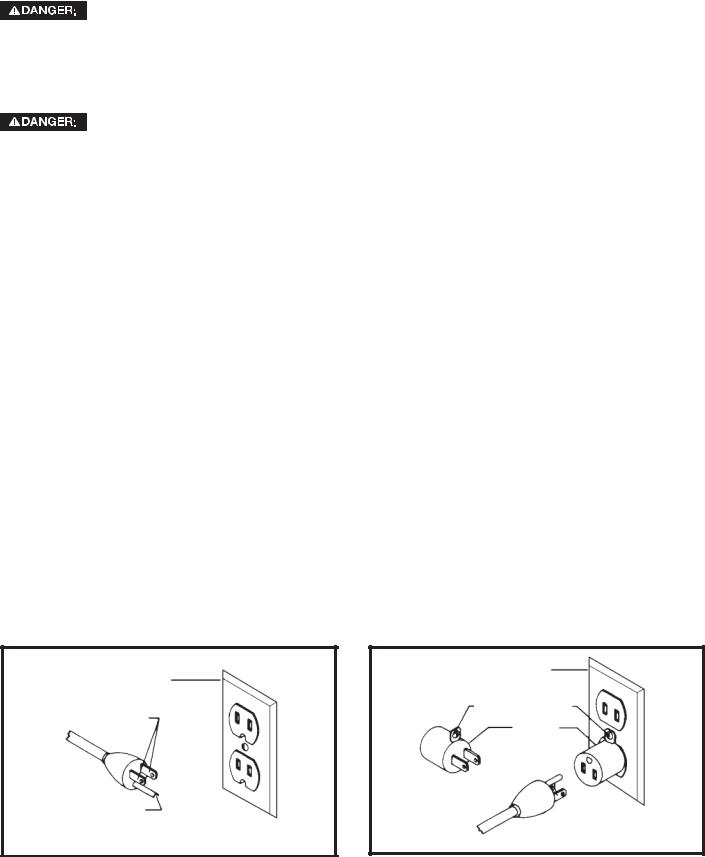
POWER CONNECTIONS
A separate electrical circuit should be used for your machines. This circuit should not be less than #12 wire and should be protected with a 20 Amp time lag fuse. If an extension cord is used, use only 3-wire extension cords which have 3-prong grounding type plugs and matching receptacle which will accept the machine’s plug. Before connecting the machine to the power line, make sure the switch (s) is in the “OFF” position and be sure that the electric current is of the same characteristics as indicated on the machine. All line connections should make good contact. Running on low voltage will damage the machine.
Do not expose the machine to rain or operate the machine in damp locations.
MOTOR SPECIFICATIONS
Your machine is wired for 120/240 Volt, 60 HZ alternating current. Before connecting the machine to the power source, make sure the switch is in the “OFF” position.
GROUNDING INSTRUCTIONS
This machine must be grounded while in use to protect the operator from electric shock.
1.All grounded, cord-connected machines:
In the event of a malfunction or breakdown, grounding provides a path of least resistance for electric current to reduce the risk of electric shock. This machine is equipped with an electric cord having an equipment-grounding conductor and a grounding plug. The plug must be plugged into a matching outlet that is properly installed and grounded in accordance with all local codes and ordinances.
Do not modify the plug provided - if it will not fit the outlet, have the proper outlet installed by a qualified electrician.
Improper connection of the equipment-grounding conductor can result in risk of electric shock. The conductor with insulation having an outer surface that is green with or without yellow stripes is the equipment-grounding conductor. If repair or replacement of the electric cord or plug is necessary, do not connect the equipment-grounding conductor to a live terminal.
Check with a qualified electrician or service personnel if the grounding instructions are not completely understood, or if in doubt as to whether the machine is properly grounded.
Use only 3-wire extension cords that have 3-prong grounding type plugs and matching 3-conductor receptacles that accept the machine’s plug, as shown in Fig. A.
Repair or replace damaged or worn cord immediately.
2.Grounded, cord-connected machines intended for use on a supply circuit having a nominal rating less than 150 volts:
If the machine is intended for use on a circuit that has an outlet that looks like the one illustrated in Fig. A, the machine will have a grounding plug that looks like the plug illustrated in Fig. A. A temporary adapter, which looks like the adapter illustrated in Fig. B may be used to connect this plug to a matching 2-conductor receptacle as shown in Fig. B if a properly grounded outlet is not available. The temporary adapter should be used only until a properly grounded outlet can be installed by a qualified electrician. The green-colored rigid ear, lug, and the like, extending from the adapter must be connected to a permanent ground such as a properly grounded outlet box. Whenever the adapter is used, it must be held in place with a metal screw.
NOTE: In Canada, the use of a temporary adapter is not permitted by the Canadian Electric Code.
 In all cases, make certain that the receptacle in question is properly grounded. If you are not sure, have a qualified electrician check the receptacle.
In all cases, make certain that the receptacle in question is properly grounded. If you are not sure, have a qualified electrician check the receptacle.
GROUNDED OUTLET BOX |
GROUNDED OUTLET BOX |
|
|
|
|
CURRENT |
GROUNDING |
|
|
MEANS |
|
CARRYING |
|
|
|
|
|
PRONGS |
|
ADAPTER |
|
|
|
GROUNDING BLADE
IS LONGEST OF THE 3 BLADES
Fig. A |
6 |
Fig. B |
|
|
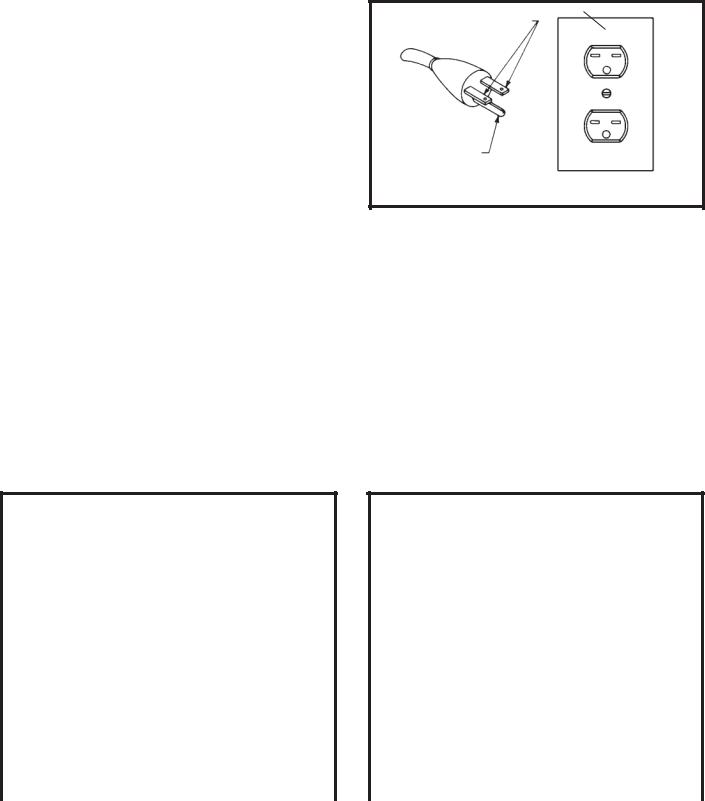
3. 240 VOLT SINGLE PHASE OPERATION
The motor supplied with your machine is a dual voltage, 120/240 volt motor. It is shipped ready-to-run for 120 volt operation. However, it can be converted for 240 volt operation.
A qualified electrician should do the conversion, or the machine can be taken to an Authorized Delta Service Center. When completed, the machine must conform to the National Electric Code and all local codes and ordinances.
The machine is converted by re-wiring the motor for 240 volts, installing a 240 volt plug on the power supply cord and replacing the switch (if necessary) with one that is rated for 240 volt operation.
Be sure the 240 volt plug is only used in an outlet having the same configuration as the plug illustrated in Fig. C. No adapter should be used with the 240 volt plug.
GROUNDED OUTLET BOX
CURRENT
CARRYING
PRONGS
GROUNDING BLADE
IS LONGEST OF THE 3 BLADES
Fig. C
 In all cases, make certain that the receptacle in question is properly grounded. If you are not sure, have a qualified electrician check the receptacle.
In all cases, make certain that the receptacle in question is properly grounded. If you are not sure, have a qualified electrician check the receptacle.
EXTENSION CORDS
 Use proper extension cords. Make sure your extension cord is in good condition and is a 3- wire extension cord which has a 3-prong grounding type plug and matching receptacle which will accept the machine’s plug. When using an extension cord, be sure to use one heavy enough to carry the current of the machine. An undersized cord will cause a drop in line voltage, resulting in loss of power and overheating. Fig. D- 1 or D-2, shows the correct gauge to use depending on the cord length. If in doubt, use the next heavier gauge. The smaller the gauge number, the heavier the cord.
Use proper extension cords. Make sure your extension cord is in good condition and is a 3- wire extension cord which has a 3-prong grounding type plug and matching receptacle which will accept the machine’s plug. When using an extension cord, be sure to use one heavy enough to carry the current of the machine. An undersized cord will cause a drop in line voltage, resulting in loss of power and overheating. Fig. D- 1 or D-2, shows the correct gauge to use depending on the cord length. If in doubt, use the next heavier gauge. The smaller the gauge number, the heavier the cord.
MINIMUM GAUGE EXTENSION CORD
RECOMMENDED SIZES FOR USE WITH STATIONARY ELECTRIC MACHINES
Ampere |
|
Total Length |
Gauge of |
Rating |
Volts |
of Cord in Feet |
Extension Cord |
0-6 |
120 |
up to 25 |
18 AWG |
0-6 |
120 |
25-50 |
16 AWG |
0-6 |
120 |
50-100 |
16 AWG |
0-6 |
120 |
100-150 |
14 AWG |
6-10 |
120 |
up to 25 |
18 AWG |
6-10 |
120 |
25-50 |
16 AWG |
6-10 |
120 |
50-100 |
14 AWG |
6-10 |
120 |
100-150 |
12 AWG |
|
|
|
|
10-12 |
120 |
up to 25 |
16 AWG |
10-12 |
120 |
25-50 |
16 AWG |
10-12 |
120 |
50-100 |
14 AWG |
10-12 |
120 |
100-150 |
12 AWG |
|
|
|
|
12-16 |
120 |
up to 25 |
14 AWG |
12-16 |
120 |
25-50 |
12 AWG |
12-16 |
120 |
GREATER THAN 50 FEET NOT RECOMMENDED |
|
|
|
|
|
Fig. D-1
MINIMUM GAUGE EXTENSION CORD
RECOMMENDED SIZES FOR USE WITH STATIONARY ELECTRIC MACHINES
Ampere |
|
Total Length |
Gauge of |
Rating |
Volts |
of Cord in Feet |
Extension Cord |
0-6 |
240 |
up to 50 |
18 AWG |
0-6 |
240 |
50-100 |
16 AWG |
0-6 |
240 |
100-200 |
16 AWG |
0-6 |
240 |
200-300 |
14 AWG |
6-10 |
240 |
up to 50 |
18 AWG |
6-10 |
240 |
50-100 |
16 AWG |
6-10 |
240 |
100-200 |
14 AWG |
6-10 |
240 |
200-300 |
12 AWG |
|
|
|
|
10-12 |
240 |
up to 50 |
16 AWG |
10-12 |
240 |
50-100 |
16 AWG |
10-12 |
240 |
100-200 |
14 AWG |
10-12 |
240 |
200-300 |
12 AWG |
|
|
|
|
12-16 |
240 |
up to 50 |
14 AWG |
12-16 |
240 |
50-100 |
12 AWG |
12-16 |
240 |
GREATER THAN 100 FEET NOT RECOMMENDED |
|
|
|
|
|
Fig. D-2
7
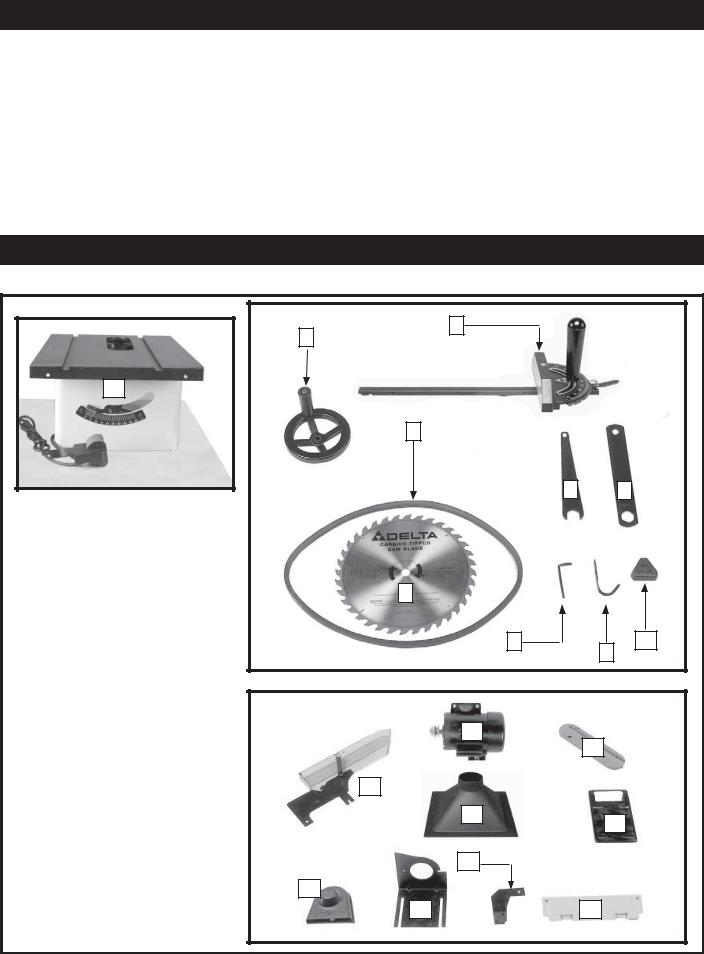
FUNCTIONAL DESCRIPTION
FOREWORD
Delta Models 36-978 and 36-979 are left-tilting 10" contractor saws with a built-in mobility kit. The saws have a powerful 1-1/2 HP induction motor which can handle tough cutting operations. The 36-978 comes with sheet metal wings and the 36-979 comes with cast iron wings.
 A rip fence assembly is not packaged with the product. You must install and use a rip fence system for ripping operations.
A rip fence assembly is not packaged with the product. You must install and use a rip fence system for ripping operations.
NOTICE: The photo on the manual cover illustrates the current production model. All other illustrations contained in the manual are representative only and may not depict the actual labeling or accessories included. These are intended to illustrate technique only.
CARTON CONTENTS
TABLE SAW PARTS
|
|
3 |
|
|
|
|
2 |
|
|
|
1 |
|
|
|
|
|
6 |
|
|
|
|
4 |
5 |
|
1. |
Table Saw |
|
|
|
2. |
Handwheel (2) |
|
|
|
3. |
Miter Gauge |
|
|
|
4. |
7/8" Open End Wrench |
|
|
|
5. |
7/8" and 1/2" Close End Wrench |
7 |
|
|
6. |
Drive Belt |
|
||
|
|
|||
7. |
Saw Blade |
|
|
|
8. |
4mm Hex Wrench |
8 |
10 |
|
9. |
Wrench Hook |
|||
|
9 |
|||
10. |
Lock Knob (2) |
|
|
|
11. |
Blade Guard and Splitter Assembly |
|
|
|
12. |
Motor |
|
|
|
13. |
Table Insert |
|
|
|
14. |
Belt Guard |
12 |
|
|
15. |
Motor Plate |
|
13 |
|
16. |
Dust Collector Adaptor |
|
|
|
17. |
Splitter Bracket |
11 |
|
|
18. |
Pulley Guard Plate |
|
||
|
|
|||
19. |
Back Brace |
16 |
15 |
|
|
|
|||
|
|
|
||
|
|
17 |
|
|
|
|
14 |
|
|
|
|
18 |
19 |
|
|
|
8 |
|
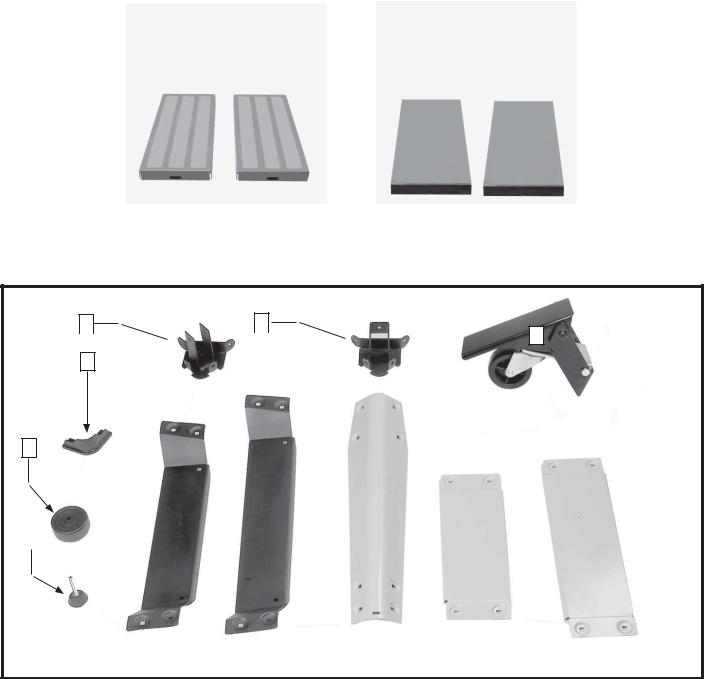
EXTENSION WINGS
MODEL 36-978 |
|
MODEL 36-979 |
2 SHEET METAL |
|
2 CAST IRON EXTENSION |
EXTENSION WINGS |
|
WINGS |
|
|
|
STAND AND MOBILE BASE PARTS
2 |
3 |



 4 1
4 1
5
6 |
|
|
|
|
|
|
|
|
|
|
|
7 |
|
8 |
|
9 |
|
10 |
|
11 |
|
|
|
|
|
|
|
|
|
|
|
|
1. |
Plastic Foot (4) |
7. |
Short Side Leg Support (2) |
2. |
Corner Bracket (left side) (2) |
8. |
Long Side Leg Support (2) |
3. |
Corner Bracket (right side) (2) |
9. |
Leg (4) |
4. |
Caster Assembly |
10. |
Short Panel For Back and Front (2) |
5. |
Wheel (2) |
11. |
Long Panel for Sides (2) |
6.Leveling Foot (2)
9
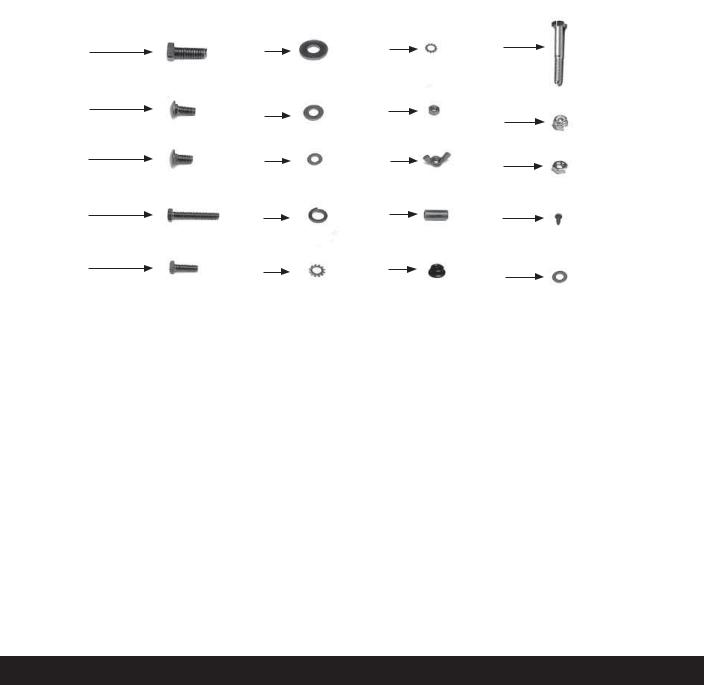
HARDWARE
|
|
|
|
|
|
|
|
|
|
|
|
|
1 |
|
6 |
|
11 |
|
|
16 |
|
|
|
|
|
|
|
|
|
|
|
|
|
|
2 |
|
7 |
|
12 |
|
|
|
|
|
|
|
|
|
|
|
|
|
17 |
|
|
|
|
|
|
|
|
|
|
|
|
|
|
3 |
|
8 |
|
13 |
|
|
|
|
|
|
|
|
|
|
18 |
|
|||
|
|
|
|
|
|
|
|
|
|
|
|
|
|
|
|
|
|
|
|
|
|
|
|
|
|
|
|
|
|
|
|
|
|
|
4 |
|
9 |
|
14 |
|
|
19 |
|
|
|
|
|
|
|
|
||||
|
|
|
|
|
|
|
|
|
|
|
|
|
|
|
|
|
|
|
|
|
|
|
|
5 |
|
10 |
|
15 |
|
|
|
|
|
|
|
|
|
|
20 |
|
|||
|
|
|
|
|
|
|
|
|
|
|
|
|
|
|
|
|
|
|
|||
|
|
|
|
|
|
|
|
|
|
|
1. |
7/16 - 20 x 1-1/4" Hex Head Bolt (6) |
11. |
1/4" External Tooth Lockwasher (4) |
|||||||
2. |
5/16 -18 x 3/4" Carriage Head Bolt (8) |
12. |
1/4 -20 Hex Nut (1) |
|||||||
3. |
5/16 -18 x 5/8" Carriage Head Bolt (50) |
13. |
1/4 -20 Wing Nut (1) |
|||||||
4. |
1/4 -20 x 1-1/2" Hex Head Bolt (1) |
|
|
14. |
Spacer (1) |
|||||
5. |
1/4 -20 x 3/4" Hex Head Bolt (2) |
|
|
15. |
5/16 -18 Serrated Hex Nut (57) |
|||||
6. |
7/16" Flat Washer (6) |
|
|
16. |
5/16 -18 x 2-1/4” Hex Head Cap Bolt (2) |
|||||
7. |
5/16" Flat Washer (1) |
|
|
17. |
5/16 -18 Nylok Nut (2) |
|||||
8. |
1/4" Flat Washer (3) |
|
|
18. |
5/16 -18 Hex Jam Nut (5) |
|||||
9. |
7/16" Lockwasher (6) |
|
|
19. |
M4 x 8mm Pan Head Screw |
|||||
10. |
5/16" External Tooth Lockwasher (1) |
20. |
10mm Nylon Flat Washer (2) |
|||||||
UNPACKING AND CLEANING
Carefully unpack the machine and all loose items from the shipping container(s). Remove the rust-preventative oil from unpainted surfaces using a soft cloth moistened with mineral spirits, paint thinner or denatured alcohol.
 Do not use highly volatile solvents such as gasoline, naphtha, acetone or lacquer thinner for cleaning your saw.
Do not use highly volatile solvents such as gasoline, naphtha, acetone or lacquer thinner for cleaning your saw.
After cleaning, cover the unpainted surfaces with a good quality household floor paste wax.
ASSEMBLY
ASSEMBLY TOOLS REQUIRED
7/8" Open End Wrench (supplied)
7/8" and 1/2" Close End Wrench (supplied) 4mm Hex Wrench (supplied)
1/4” Hex Wrench (not supplied)
Socket or Open-End Wrenches, including 10mm, 12mm, 18mm,1/2 inch and a Phillips screwdriver (not supplied)
ASSEMBLY TIME ESTIMATE
Assembly for this machine takes approximately 4-6 hours.
 For your own safety, do not connect the machine to the power source until the machine is completely assembled and you read and understand the entire instruction manual.
For your own safety, do not connect the machine to the power source until the machine is completely assembled and you read and understand the entire instruction manual.
10

MOBILE BASE AND STAND ASSEMBLY
Put the stand together upside down for easier assembly.
FRONT AND SIDE PANELS
1.Insert a 5/16 -18 x 5/8" carriage head bolt (A) Fig. 1 through the leg (B) and the corresponding hole in the panel (C) Fig. 1.
NOTE: Make sure the squares of the bolt align with the flat sides of the hole opening.
2.Thread a 5/16 -18 serrated hex nut (D) Fig. 2 on the screw. Finger tighten the panel to the leg. Make sure that the serrated face of the hex nut is against the panel.
NOTE: Loosely tighten the hardware for further adjustment.
3.Fig. 3 shows all four legs attached to the front and side panels.
NOTE: Make sure that the short panels are opposite short panels and long panels are opposite long panels.
SHORT AND LONG LEG SUPPORTS
4.Attach the long side leg supports (E) Fig. 4 and the short side leg supports to the legs using 5/16 -18 x 5/8" carriage head bolts and 5/16 -18 serrated hex nuts. Insert the bolt through the leg first and then the support.
NOTE: Be sure the holes (J) Fig. 5 in all side supports are aligned.
5.Thread the hex nut on the bolt and finger tighten only. Attach eight screws and eight nuts in the holes - two of which are shown at (F) Fig. 5. Make sure these holes are on the bottom (after saw is turned upright).
CORNER BRACKETS
B A
C
Fig. 1
Fig. 3 |
F
J
Fig. 5 |
6.Align the corner bracket (G) Fig. 6 that has the closed end with the holes (I) in the leg supports.
NOTE: Attach the closed-end brackets to the long leg support that has the 3 holes in the middle (Fig. 9). If necessary, use a soft hammer (or a regular hammer and block of wood) to tap the corner bracket to align the holes (Fig. 7).
7.Once aligned, attach the corner bracket to the leg supports using the 5/16 -18 x 5/8" carriage head bolts and 5/16 -18 serrated hex nuts. Insert the bolt through the support and the corner bracket at (K) Fig. 8. Thread a hex nut on the screw and tighten.
8.Attach the leg to the corner bracket usingthelonger5/16-18x3/4"carriage head bolts and 5/16-18 serrated hex nuts in the two holes, one of which is shown at (L) Fig. 8.
9.Repeat for the other corner bracket. You will install the rubber leveling feet on these brackets (G) Fig. 12.
10.Attach the brackets with the open end
(M)Fig. 10 the same as described in Steps 6 to 9.
Fig. 7 |
G
Fig. 9 |
D
Fig. 2 |
E
Fig. 4 |
I
H
G
Fig. 6 |
K

 L
L
Fig. 8

 M
M
Fig. 10 |
11
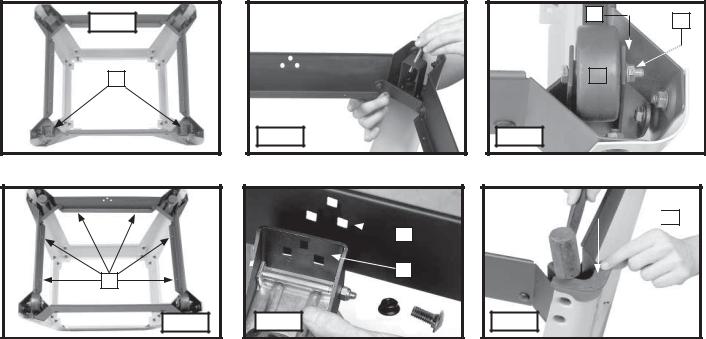
NOTE: Align the open end as shown in Figs. 10 and 11 where the wheels will be installed later.
LEVELING FEET
11.Thread one 5/16 -18 hex jam nut on the post of one of the leveling feet. Insert this assembly into the hole of the enclosed corner bracket (Fig. 12). Place another 5/16 -18 hex jam nut on the post and tighten. Move the hex nuts up or down on the post to adjust the height of the foot. Repeat for the other leveling foot.
WHEELS
12.Place a wheel (N) Fig. 13 in an open-end bracket (O). Insert a 5/16 -18 x 2-1/4” hex head cap screw through the bracket and the wheel. Fasten it together as shown in Fig. 13 with a 5/16 - 18 Nylok Nut (P).
13.Tighten all hardware - first on the panels, then on the leg supports.
ATTACHING THE FOOT LEVER TO THE BASE
Align the three holes in the foot lever (W) Fig. 15 with the three holes in the base (X). Place a 5/16-18 x 5/8" carriage bolt through the lever and the base. Secure the lever to the base with a 5/16-18 serrated nut.
PLASTIC FEET
Install the Plastic Feet (Y) Fig. 16. Tap the feet in place with a soft hammer or with a regular hammer and a block of wood.
ADDING AN OPTIONAL SHELF
You can install an optional shelf made from a piece of 3/4" plywood measuring 22-3/8” x 19-1/4” (568.96 mm x 488.95 mm). To install, screw the wood to the leg supports through the (8) holes in the leg supports, six of which are shown at (Q) Fig. 14. When the stand is upside down (as in Fig. 14), place the shelf underneath the overhangs of the leg supports. When the stand is upright, the shelf would be on top of the leg support overhangs. To install the shelf, remove one side panel. Make sure this panel is re-installed before using the saw. See the exact measurements for this shelf in the back of this manual.
Fig. 11 |
O |
P |
|
|
|
N |
|
M |
|||
|
|
Fig. 12 |
Fig. 13 |
Q
Fig. 14 |
Fig. 15 |
 W
W
X
 Y
Y
Fig. 16 |
12
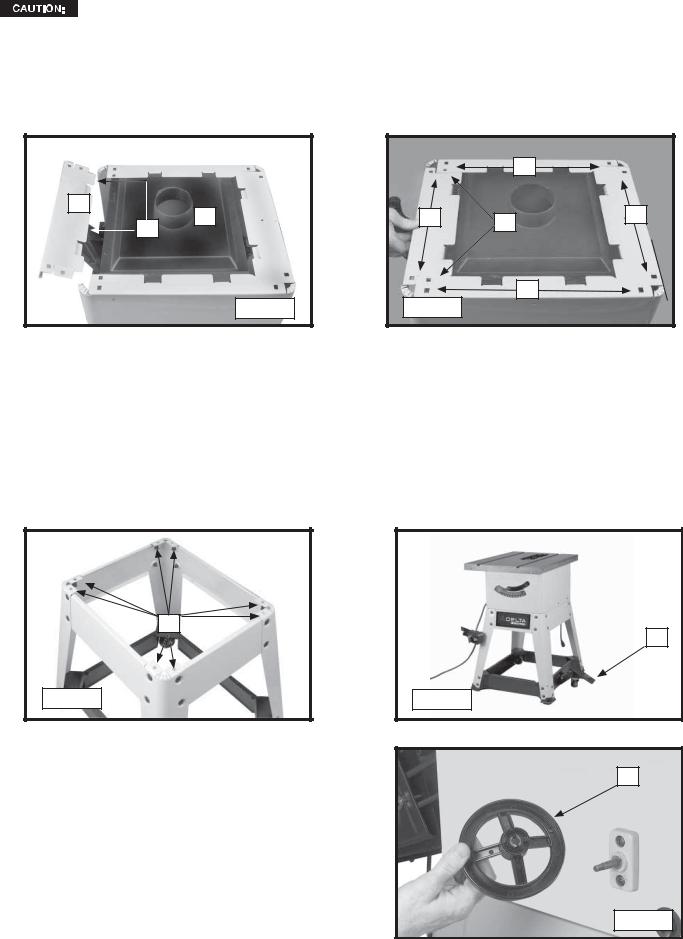
DUST CHUTE AND BACK BRACE
Do not install this dust chute unless you will be using a dust collector.
To install the dust chute and back brace, place the saw unit upside down on the floor as shown in Fig. 17.
 During installation of the dust chute, protect the saw's table top by placing a protective barrier between the saw and the floor (cardboard, carpet, etc.).
During installation of the dust chute, protect the saw's table top by placing a protective barrier between the saw and the floor (cardboard, carpet, etc.).
Slide the dust chute in place (A) Fig. 17. Place the back brace (B) with tabs (C) Fig. 17 below the chute edge (Fig. 18). To fasten the back brace to the saw unit, place 5/16 - 18 x 5/8" carriage head bolts up from inside the saw cabinet through the holes (E). Thread 5/16 - 18 serrated hex nuts on the screws. Tighten securely.
|
|
|
D |
B |
|
|
D |
A |
D |
E |
|
C |
|
|
|
|
|
|
|
|
|
|
D |
Fig. 17 |
Fig. 18 |
|
|
ATTACHING THE MOBILE BASE AND STAND TO THE SAW
 To prevent personal injury or damage to the machine, follow these directions:
To prevent personal injury or damage to the machine, follow these directions:
1.With the saw already upside down from installing the dust chute and the back brace, place the mobile base and stand assembly on top of the upside-down saw. Align the eight holes in the legs (A) Fig. 19) with the eight holes (D) Fig. 18.
NOTE: Place the shorter panel with the Delta nameplate on the front next to the scale and pointer.
2.From the inside of the saw cabinet, place a 5/16 -18 x 5/8" carriage head bolt in the holes (D) Fig. 26, and through the legs. Thread a 5/16 -18 serrated hex nut on the bolt. Tighten it securely. Repeat for all eight holes.
3. With a minimum of two people, carefully stand the saw upright (Fig. 20).
4.To check the table level, lift up on the foot pedal (C) Fig. 20 to disengage the mobile base. Use a carpenter's level. If the machine is not level, make adjustments to the leveling feet as described in “LEVELING FEET” section. To make the saw mobile, push down on the foot pedal.
|
A |
|
C |
Fig. 19 |
Fig. 20 |
ATTACHING THE BLADE-ADJUSTING HANDWHEELS
1.Place the tilt-adjusting handwheel (A) Fig. 21 on the shaft (B). Engage the slot in the handwheel (C) with the roll pin (D) on the shaft.
2.Place a 10mm Nylon Flat Washer (E) on the shaft (B). Thread the locking knob (F) on the shaft.
3.Attach the elevation handwheel (G) Fig. 22 to the front of the saw in the same manner.
A
Fig. 21
13
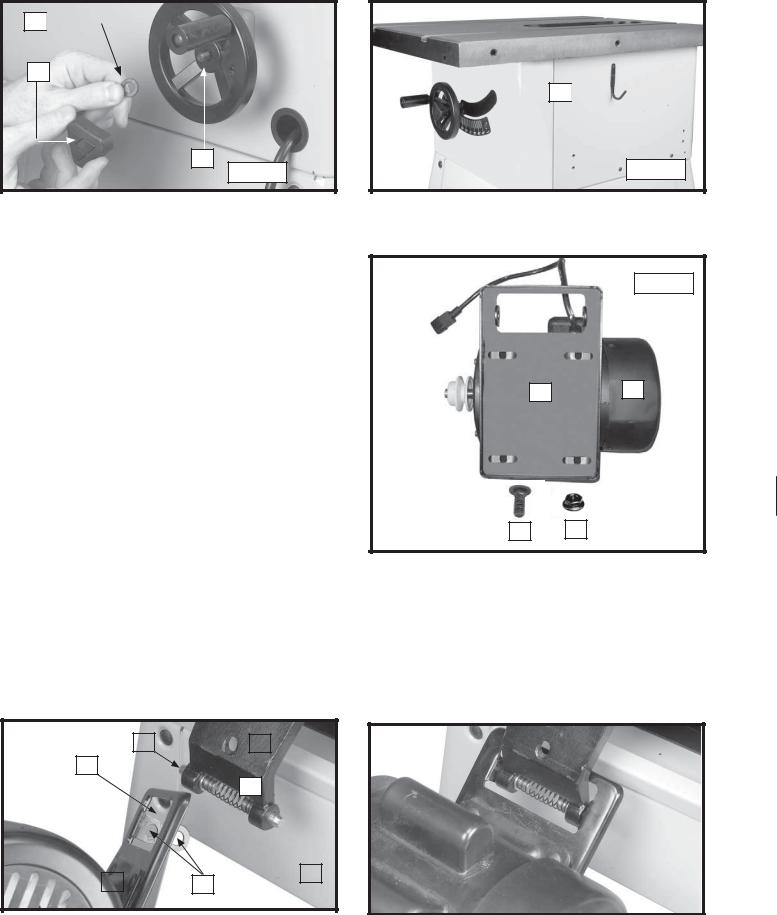
E 

F
H 

B
Fig. 22 |
Fig. 23 |
WRENCH HOOK
A hook (H) Fig. 23 for blade wrench storage can be installed in two holes on the side of the saw using two M4x8mm Pan Head Cap Screws.
Fig. 24
MOTOR TO MOTOR MOUNTING PLATE
Attach the motor (A) to the motor mounting plate (B) Fig. 24.
Align the four mounting holes in the motor with the four holes
in the mounting plate. Insert a 5/16-18 x 5/8" carriage bolt
(C) through the hole in the motor and and the hole in the B A motor mounting plate. Fasten with a 5/16-18 serrated nut
(E). Repeat this process for the three remaining holes in the motor and the motor mounting plate.
NOTE: Loosely tighten the hex nuts for further adjustment.
C E
ATTACHING THE MOTOR AND MOTOR MOUNTING PLATE TO THE SAW
1.Position the motor and motor mounting plate (A) Fig. 25 below the bracket (B) to allow bracket arm to slide through the large opening (C) in the motor mounting plate (A).
2.Depress the pins (D) Fig. 25 on both sides of bracket (B). Lift the motor mounting plate (A) until the pins (D) are engaged in the holes (E) Fig. 25 of motor mounting plate (A).
3.The motor and motor mounting plate are shown attached to the rear of the saw in Fig. 26.
D |
|
B |
C
D
|
|
|
|
|
|
D |
|
|
A |
|
|
|
|
|
|
|
|
|
E |
|
|
|
|
|
||
|
|
Fig. 25 |
|
|
|
Fig. 26 |
||
|
|
|
|
|
|
|
||
|
|
|
|
|
||||
|
|
|
|
|
|
|
|
|
14

ATTACHING THE MOTOR PULLEY, THE PULLEY GUARD, AND THE DRIVE BELT
1.Slide the belt and pulley guard bracket (I) Fig. 27, between the motor plate (J) and motor mounting plate (K).
2.Place a 1/4" external tooth lockwasher on 1/4 -20 x 1-1/2"
hex head bolt. Insert the bolt (L) Fig. 27 through the hole in |
|
|
|
|
the belt and pulley guard bracket (I) Fig. 27. |
|
|
|
I |
3. Position the belt and pulley guard bracket (I) Fig. 28, so that |
|
|
|
|
|
|
|
|
|
the motor pulley (K) is centered and through the hole in the |
L |
|
|
|
|
|
|
||
belt and pulley guard bracket (I) Fig. 28. Tighten the four hex |
|
|
|
|
nuts (C) Fig. 24 that fasten the motor to the motor mounting |
|
|
|
|
plate. |
|
|
|
|
4.Use a straight edge to align the motor pulley with the arbor pulley in the saw cabinet. If necessary, adjust the motor
pulley (K) Fig. 28 in or out on the motor shaft. |
Fig. 27 |
5.Raise the motor and attach the drive belt (L) Fig. 29 to the arbor pulley and the motor pulley (K) Fig 29. The weight of the motor will provide the correct belt tension.
I |
P |
Q |
|
|
|
|
L |
|
L |
|
|
Fig. 28 |
|
K |
K |
|
Fig. 29 |
6.Place a 1/4" flat washer and a spacer (P) Fig. 28 on the 1/4 - 20 x 1-1/2" hex head screw (L). Thread a 1/4 - 20 hex nut
(Q) Fig. 28 on the screw post until it tightens the spacer on the pulley guard (I) Fig. 28.
7.Install the belt guard (R) Fig. 30. Position it so that the 1/4- 20 x 1-1/2" hex head bolt (L) Fig. 28 goes into the hole in the belt guard. Place a 1/4" external tooth lockwasher and a 1/4-20 wing nut on the hex head bolt (S) Fig 30. Tighten securely.
R
S
Fig. 30
 Do not allow the belt guard to contact the drive belt or the motor pulley.
Do not allow the belt guard to contact the drive belt or the motor pulley.
|
|
|
The motor end (N) Fig. 31 must be below the top of |
|
|
M |
|
|
|
|
|
||
|
|
|
|
|
||
the table surface. Immediately after attaching the belt, raise the |
|
|
|
|||
saw blade to its maximum height and tilt the saw blade 45°. Use a |
|
|
|
|||
straight edge (M) Fig. 31 to see if the motor end (N) Fig. 31 is below |
|
|
|
|||
the top of the table surface (O). If not, loosen the four hex nuts (F) |
|
|
|
|||
N |
|
|
||||
Fig. 24, reposition the motor, and tighten the nuts. Re-align the |
|
|||||
|
|
|
||||
motor pulley (K) Fig. 29 with the arbor pulley. |
|
|
|
|||
O
Fig. 31
15

CONNECTING THE MOTOR CORD TO THE SWITCH ASSEMBLY
Insert the motor plug (A) Fig. 32 into the female receptacle
(B) of the switch-to-motor cord, located inside the saw housing.
 Clamp the cord that runs from the switch to the female end (B) Fig. 32 to the inner wall of the saw unit. Do Not allow it to come in contact with the blade or any moving parts.
Clamp the cord that runs from the switch to the female end (B) Fig. 32 to the inner wall of the saw unit. Do Not allow it to come in contact with the blade or any moving parts.
 B
B
A
Fig. 32
REMOVING THE MOTOR FOR TRANSPORT
To remove the motor for transport, unplug the motor cord from the switch cord. Hold the motor, press in on the pins
(G) Fig. 33 and lower motor off of bracket.
G |
Fig. 33 |
BLADE GUARD AND SPLITTER ASSEMBLY AND ALIGNMENT
1.Fasten the rear splitter mounting bracket (A) Fig. 34 to the rear trunnion. Align the two holes in the rear splitter mounting bracket (B) with the two holes in the trunnion. Place a 1/4" lock washer and a 1/4" flat washer on a 1/4-20 x 3/4" hex head bolt. Position the bolt through the hole in the rear splitter mounting bracket. Thread the bolt into the rear trunnion. Repeat this process for the remaining hole. Loosely tighten the hardware for further adjustment.
2.Raise saw arbor to its highest position.
|
B |
|
|
|
A |
|
|
Fig. 34 |
X |
Y |
Z |
|
3. Remove the screw, lock washer and large washer (C) |
C |
|
|
Fig. 35 (and pictured in inset) from the inside splitter |
|
mounting bracket. |
|
Fig. 35
16
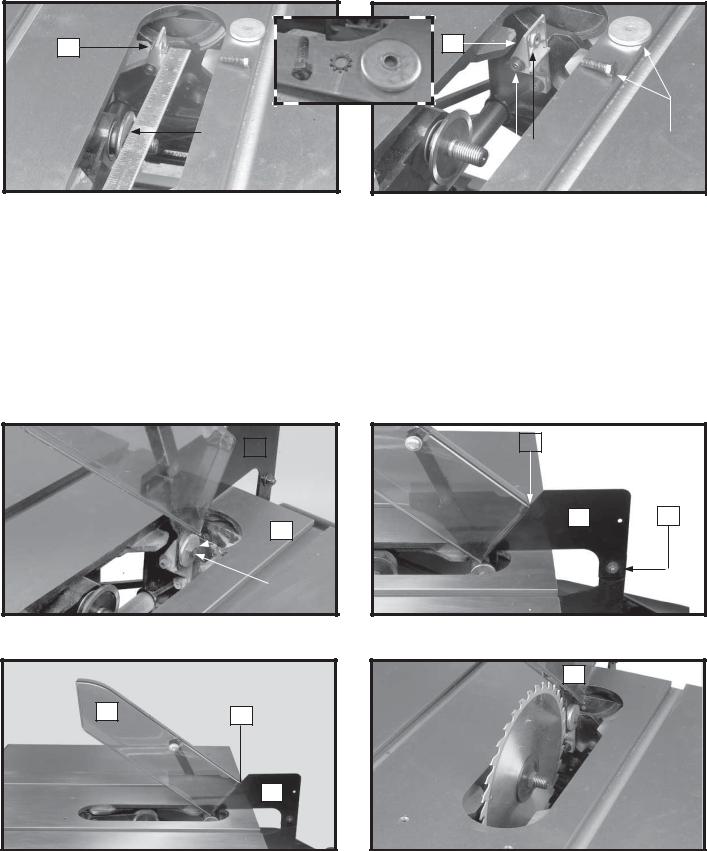
4.Use a straight edge to see if the top and bottom of the inside splitter bracket (D) Fig. 36 is aligned with the inner arbor flange (E).
5.If alignment is necessary, loosen the two screws, (F) Fig. 37, align the bracket (D) with the arbor flange and tighten the screws (F).
6.Loosely attach the large washer, lock washer and screw (inset) Figs. 36 and 37 (removed earlier) to the inside splitter bracket.
D |
D |
|
|
|
E |
|
|
|
|
|
|
|
|
|
F |
|
|
C |
|
|
|
|
|
|
|
|
|
||
|
|
|
|
|||||
Fig. 36 |
|
|
|
|
|
Fig. 37 |
||
|
|
|
|
|
|
|
|
|
7.Attach the blade guard and splitter assembly (G) Fig. 38 between the large washer (C) and the splitter bracket. Tighten the screw (H) with the supplied wrench. Slide the splitter as far down as it will go.
8.Fasten the rear of the blade guard and splitter bracket assembly (G) Fig. 39 to the rear splitter mounting bracket. Align the hole (J) in the blade guard and splitter bracket with the hole in the rear splitter mounting bracket. Insert a 5/16-18 x 5/8" carriage head bolt through the hole (J). Place a 5/16" flat washer and external tooth lock washer on the bolt and fasten with a 5/16-18 hex nut. Tighten securely.
IMPORTANT: The splitter (G) Fig. 40 has a notch (L) cut in the top edge. This feature enables the blade guard to stay in the raised position to make blade changing easier. Raise the front of blade guard (M) until the rear edge of the blade guard slips into the notch (L) of the splitter (G). This feature only works when the table insert is removed.
9.With the blade guard (L) Fig. 41 in the raised position, attach the saw blade (K) on the arbor with the two arbor wrenches. For more instructions on changing blades, see “CHANGING THE SAW BLADE” section in this manual.
|
|
L |
|
G |
|||
|
|
||
|
|
|
G J
 H
H
|
|
C |
|
|
Fig. 38 |
|
|
Fig. 39 |
|
|
|
|
L
M |
L |
|
G
Fig. 40 |
|
Fig. 41 |
17
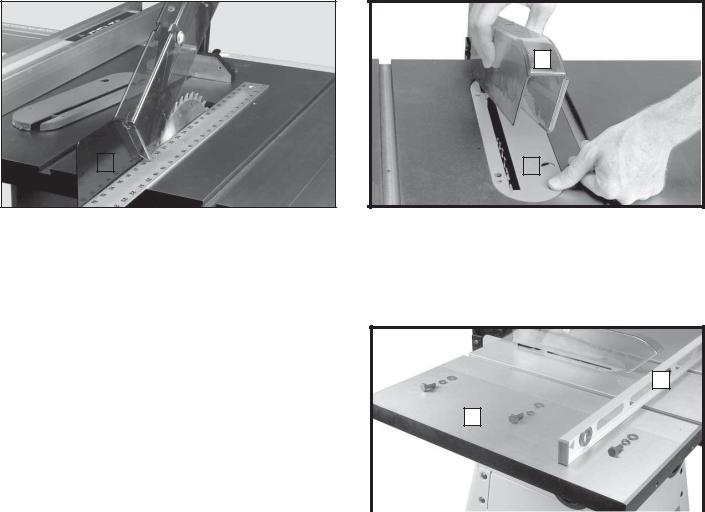
10.Use a straight edge to see if the rear of the splitter (G) is aligned with the saw blade (Fig. 42). If alignment is necessary, loosen the screws (B) Fig. 34, align the splitter (G) with the saw blade, and tighten the screws (B) Fig. 34.
11.Lower the saw blade and install the table insert (P) Fig. 43 in the saw table.
 The table insert should be level with the table surface. If an adjustment is necessary, see the section
The table insert should be level with the table surface. If an adjustment is necessary, see the section
"ADJUSTING THE TABLE INSERT".
 Hold on to the blade guard (L) when you install the table insert. The insert will automatically release the holding action of the splitter and lower the blade guard when it is installed in the table opening.
Hold on to the blade guard (L) when you install the table insert. The insert will automatically release the holding action of the splitter and lower the blade guard when it is installed in the table opening.
L
G |
|
|
|
|
|
|
|
|
|
|
|
R |
|
|
|
|
|
|
|
|
|
|
|
|
|
|
|
|
|
Fig. 42 |
|
Fig. 43 |
|
|
|
|
|
|
|
|
|
EXTENSION WINGS
1.Attach the extension wing (A) Fig. 44 to the saw table. Align the three holes in the extension wing with the three holes in the side of the saw table. Place a 7/16" Lockwasher and a 7/16" flat washer on a 7/16-20 x 1-1/4" hex head bolt (hardware assemblies shown on wing (A), Fig. 44.)
2.Insert the screw through the hole in the extension wing. Thread the screw into the tapped hole in the side of the
saw table. Finger tighten only. Repeat this process for
the two remaining holes in the extension wing and the E saw table.
A
NOTE: The extension wing must be flush with or slightly |
|
|
|
behind the front edge of the table. |
|
|
|
3. Use a straight edge (E) Fig. 44 as a guide to level the |
|
|
|
extension wing (A) with the saw table. Once level, |
|
|
|
tighten the bolt on one side. Check the level again. |
|
Fig. 44 |
|
Tighten the bolt in the middle, then tighten the bolt on |
|
|
|
|
|
|
|
the other side. |
|
|
|
MODEL 36-978 ONLY
Attach the other sheet metal extension wing to the opposite side of the saw table in the same manner.
MODEL 36-979 ONLY
Attach the other cast iron extension wing to the opposite side of the saw table in the same manner.
18
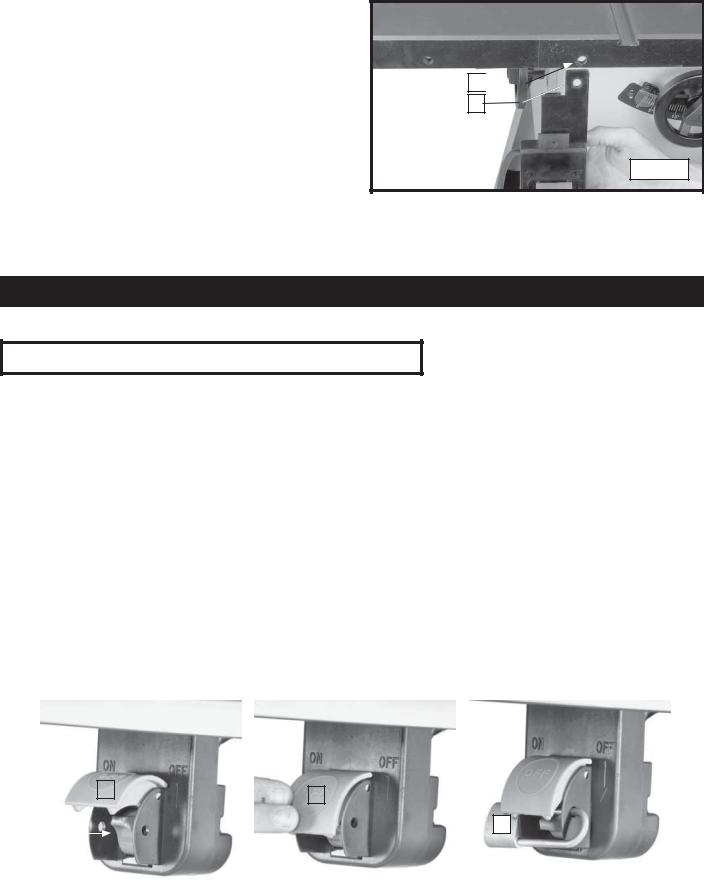
ON/OFF SWITCH
Attach the switch behind the table edge with the hardware (supplied with the fence). The screw that fastens the front fence rail will secure the switch by going though the hole
(A) Fig. 45 in the table edge and the hole (B) in the switch.
A 

B
Fig. 45
OPERATION
OPERATIONAL CONTROLS AND ADJUSTMENTS
STARTING AND STOPPING THE SAW
 Make sure that the switch is in the “OFF” position before plugging the cord into the outlet. Do not touch the plug’s metal prongs when unplugging or plugging in the cord.
Make sure that the switch is in the “OFF” position before plugging the cord into the outlet. Do not touch the plug’s metal prongs when unplugging or plugging in the cord.
1.The ON/OFF switch is located underneath the switch shield (A) Fig. 47. To turn the saw “ON”, move the switch lever (B) to the up position.
2.To turn the saw “OFF”, push down on switch shield (A) Fig. 48.
LOCKING THE SWITCH IN THE “OFF” POSITION
IMPORTANT: When the machine is not in use, the switch should be locked in the “OFF” position to prevent unauthorized use, using a padlock (C) Fig. 49 with a 3/16" diameter shackle.
 In the event of a power outage (such as a breaker or fuse trip), always move the switch to the “OFF” position until the main power is restored.
In the event of a power outage (such as a breaker or fuse trip), always move the switch to the “OFF” position until the main power is restored.
|
|
|
|
|
|
|
|
|
|
|
|
|
|
|
|
|
|
|
|
|
A |
|
|
|
|
|
|
|
|
|
|
|
|
|
|
|
|
|
|
|
|
|
|
A |
|
|
|
|
C |
||||
|
|
|
|
|
|
|
|
|
|
|
|
|
|
||||
|
|
|
|
|
|
|
|
|
|
|
|
|
|
|
|||
|
|
|
|
|
|
|
|
|
|
|
|
|
|
|
|||
|
B |
|
|
|
|
|
|
|
|
|
|
|
|
|
|||
|
|
|
|
|
|
|
|
|
|
|
|
|
|
|
|||
|
|
|
|
|
|
|
|
|
|
|
|
|
|
|
|
|
|
|
|
|
|
|
|
|
|
|
|
|
|
|
|
|
|
|
|
|
|
|
|
|
|
Fig. 47 |
|
|
|
|
|
Fig. 48 |
|
|
|
Fig. 49 |
|
|
|
|
|
|
|
|
|
|
|
|
|
|
|
|
|
|
|
19
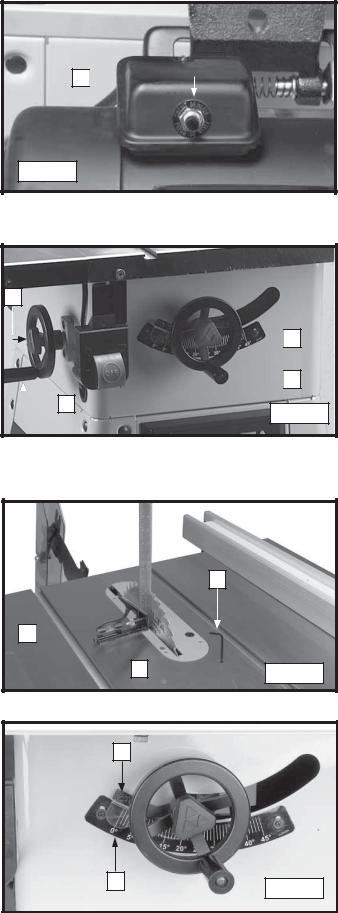
OVERLOAD PROTECTION
The motor supplied with your saw is equipped with a manual reset overload (A) Fig. 50. If the motor shuts off or fails to start due to overloading (cutting stock too fast, using a dull blade, using the saw beyond its capacity, etc.), or low voltage, move the ON/OFF switch to the “OFF” position. Let the motor cool for three to five minutes, then push the reset button (A) to reset the overload device.
RAISING AND LOWERING BLADE
To raise the saw blade, loosen the lock knob (C) Fig. 51, and turn the blade-adjusting handwheel (D) clockwise. To lower the blade, turn the handwheel (D) counterclockwise. When the blade is at the desired height, tighten the lock knob (C).
NOTE: One full turn of the handwheel will change blade height approximately 1/4".
TILTING THE BLADE
To tilt the saw blade for bevel cutting, loosen the lock knob
(A) and turn the handwheel (B). When the desired blade angle is obtained, tighten lock knob (A).
ADJUSTING 90° AND 45° POSITIVE STOPS
Your saw is equipped with positive stops that will quickly and accurately position the saw blade at 90° and 45° to the
table. To check and adjust the positive stops:
 Disconnect the machine from the power source.
Disconnect the machine from the power source.
1.Raise the saw blade to its highest position.
2.Set the blade at 90° to the table by turning the blade tilting handwheel (B) Fig. 51 counter-clockwise as far as it will go.
3.Use a combination square (A) Fig. 52 to see if the blade is at 90° to the table surface.
4.If not, turn the handwheel (B) Fig. 51 one turn clockwise. Loosen the set screw (F) Fig. 52 with a 4mm hex wrench. Turn the handwheel until the blade is at 90° to the table. Tighten the set screw (F) until it bottoms.
5.Loosen the screws (E) Fig. 53, adjust the hairline indicator
(D) to point to the 0° mark on the scale, and tighten the screws (E).
6.Turn the handwheel clockwise as far as it will go and use a combination square to see if the blade is at 45° to the table.
7.If not, turn the handwheel (B) Fig. 51 one turn counterclockwise. Loosen the set screw (B) Fig. 52. Turn the handwheel until the blade is 45° to the table. Tighten the set screw (B) until it bottoms.
D 
Fig. 50
A

 C
C

 D
D
 B
B
Fig. 51
B
A 

F |
Fig. 52 |
|
E
D
Fig. 53
20

MITER GAUGE OPERATION AND ADJUSTMENT
The miter gauge is equipped with adjustable index stops at 90°, 75°, 60°, 45° and 30°.
To rotate the miter gauge, loosen lock knob (A) Fig. 54, push the thumb lever (B) down and move the body of the miter gage
(C) to the desired angle.
The miter gauge is equipped with a washer (D) Fig. 55 which fits into the T-Slot groove (E) in the table. This allows the miter gauge to be pulled off the front edge of the table without falling. This allows for a longer cut-off capacity in front of the blade.

 A
A
C 

B 
Fig. 54
ADJUSTING THE TABLE INSERT
 Disconnect the machine from the power source.
Disconnect the machine from the power source.
Place a straight edge across the table at both ends of the table insert (A) Fig. 56.
 Make sure that the table insert (A) is always level with the table.
Make sure that the table insert (A) is always level with the table.
To adjust, turn the screws (B). The table insert is equipped with a finger hole (C) for easy removal.
ALIGNING THE MITER SLOTS TO THE BLADE
E
D |
Fig. 55 |
|
B 
C
A |
B |
Fig. 56
The saw table was aligned at the factory so that the miter gauge slots are parallel to the saw blade. However, check the alignment before initial operation.
Disconnect the machine from the power source.
1.Place a combination square (A) Fig. 57 on the table with one edge of the square in the miter gauge slot. Adjust the square so that the ruler touches one of the teeth on the saw blade at the forward position (Fig. 57). Lock the square in this position.
2.Rotate the saw blade so that the same tooth used in STEP 1 is in the rear position (Fig. 58). Check this distance. Both the front and rear measurements should be identical.
A
Fig. 57 |
|
Fig. 58 |
21

3. To adjust, loosen the two hex head bolts (B) Fig. 59 that |
B |
hold the rear trunnion to the saw table. |
|
4.Use a rubber mallet (or a regular hammer and a block of
|
wood) to tap the trunnion (C) until the saw blade is in the |
|
|
C |
|
center of the table insert slot, and parallel to the miter |
|
|
|
|
|
|
|
|
|
gauge slot. |
|
|
|
5. |
Tighten the two hex head bolts that were loosened in |
|
|
|
|
STEP 3. |
|
|
|
6. |
Tilt the blade to 45°. Turn the saw blade by hand to |
|
|
|
D |
||||
|
ensure that it does not contact the table insert. |
|
|
|
|
|
|
|
Fig. 59
CHANGING THE SAW BLADE
Use only 10" diameter blades with 5/8" arbor holes, rated at 3600 rpm or higher.
Disconnect the machine from the power source.
NOTE: Two 7/8" wrenches are supplied with the saw for changing the saw blade - a closed-end wrench (A) Fig. 61 and an open-end wrench (B).
1.Remove the table insert (C) Fig. 60, and raise the saw blade to its maximum height.
2.Place the open-end wrench (B) Fig. 61 on the flats of the saw arbor. Use the closed-end wrench (A) to turn the arbor nut
(D) toward the front of the saw to loosen. Remove the arbor nut, blade flange (C), and saw blade.
3.Place the new blade on the arbor with the teeth pointing down as the blade rotates toward the front of the saw table. Install the outside blade flange and arbor nut to secure the blade. With the wrench (B) Fig. 61 on the flats of the arbor, tighten the arbor nut by turning wrench (A) toward the rear of the saw.
4.Replace the table insert.
NOTE: Use a sharp blade that is proper for your project. Do not stack blades when you store them. Place a barrier (cardboard, cloth, etc.) between the blades to keep them from touching.
B 
 A
A
 A B
A B
C
C

 D
D
Fig. 60 |
|
|
|
Fig. 61 |
|
|
|
|
BACKLASH ADJUSTMENTS FOR BLADE RAISING AND BLADE TILTING MECHANISMS
If any play is detected in the blade-raising or blade-tilting mechanisms, make the following adjustments:
NOTE: In the illustration (Fig. 62), the machine was turned upside down and the blade removed for clarity and safety.
1.Adjusting the blade-raising mechanism - Loosen the locknut (A) Fig. 62 and turn the eccentric sleeve (B) until all play is removed. Tighten the locknut.
2.Adjusting the blade-tilting mechanism - Loosen the locknut (C) Fig. 62 and turn the eccentric (D) until all play is removed. Tighten the locknut.
D

 B
B

 A
A
C
Fig. 62
22

MACHINE USE
Common sawing operations include ripping and crosscutting plus a few other standard operations. As with all power machines, a certain amount of hazard is involved with the operation and use of the machine. Using the machine with the respect and caution will considerably lessen the possibility of personal injury. However, if normal safety precautions are overlooked or completely ignored, personal injury can result. The following information describes the safe and proper method for performing the most common sawing operations.
 This instruction manual does not provide information regarding the installation of a fence system. A fence system must be installed before use of the saw. Please refer to the fence instruction manual regarding the proper installation, alignment, and operation of the fence system.
This instruction manual does not provide information regarding the installation of a fence system. A fence system must be installed before use of the saw. Please refer to the fence instruction manual regarding the proper installation, alignment, and operation of the fence system.
The use of attachments and accessories not recommended be Delta may result in injury.
Never operate the saw without the proper table insert for the saw blade or cutter installed.
QUICK OPERATIONS CHECKLIST
 Before using the saw each time, verify the following: 1, The blade is tight.
Before using the saw each time, verify the following: 1, The blade is tight.
2.The bevel angle and height lock-knobs are tight.
3.If ripping, ensure that the fence lock lever is tight and that the fence is parallel to the blade.
4.If crosscutting, ensure that the miter gauge knob is tight.
5.Proper eye, hearing, and respiratory equipment are being used.
6.The blade guard is properly attached and the anti-kickback pawls are functioning.
Failure to adhere to these common safety rules can greatly increase the likelihood of injury.
KEY PARTS AND SAFETY FEATURES ON YOUR SAW
|
1 |
2 |
3 |
4 |
6 |
7 |
8 |
9 |
10 |
|
|
|
|
5 |
|
|
|
|
|
18 |
|
|
|
|
|
|
|
FRONT VIEW |
|
|
|
|
|
|
|
|
1. |
Extension Wing |
|
|
|
|
|
|
|
|
|
||
|
|
|
|
|
|
|
|
2. |
Miter Gauge Lock |
|
|
|
|
|
|
|
|
3. |
Miter Gauge |
|
|
|
|
|
|
11 |
|
4. |
Miter Gauge Slot |
|
|
|
|
|
|
|
5. |
Table Top |
|
|
|
|
|
|
|
|
|
||
|
|
|
|
|
12 |
|
|
6. |
Blade Guard/Splitter/Anti- |
|
|
|
|
|
|
|
|
Kickback Pawl Assembly |
|
|
16 |
14 |
|
|
|
|
|
|
|
|
|
|
|
|
|
7. |
Miter Gauge Slot |
||
17 |
15 |
|
13 |
|
|
|
|
8. |
Rip Fence |
|
|
|
|
|
9. |
Extension Wing |
|||
|
|
|
|
|
|
|
|
10. |
Extension Table |
|
|
|
|
|
|
|
|
11. |
Rip Fence Lock |
|
|
|
|
|
|
|
|
12. |
Tilt Angle Scale |
|
|
|
|
|
|
|
|
13. |
Elevation Handwheel Lock-knob |
|
|
|
|
|
|
|
|
14. |
Elevation Handwheel |
|
|
|
|
|
|
|
|
15. |
Tilt Angle Indicator |
|
|
|
|
|
|
|
|
16. |
Tilt Handwheel |
|
|
|
|
|
|
|
|
17. |
ON/OFF Switch |
|
|
|
|
|
|
|
|
18. |
Tilt Handwheel Lock-Knob |
|
|
|
|
|
|
23 |
|
|
|
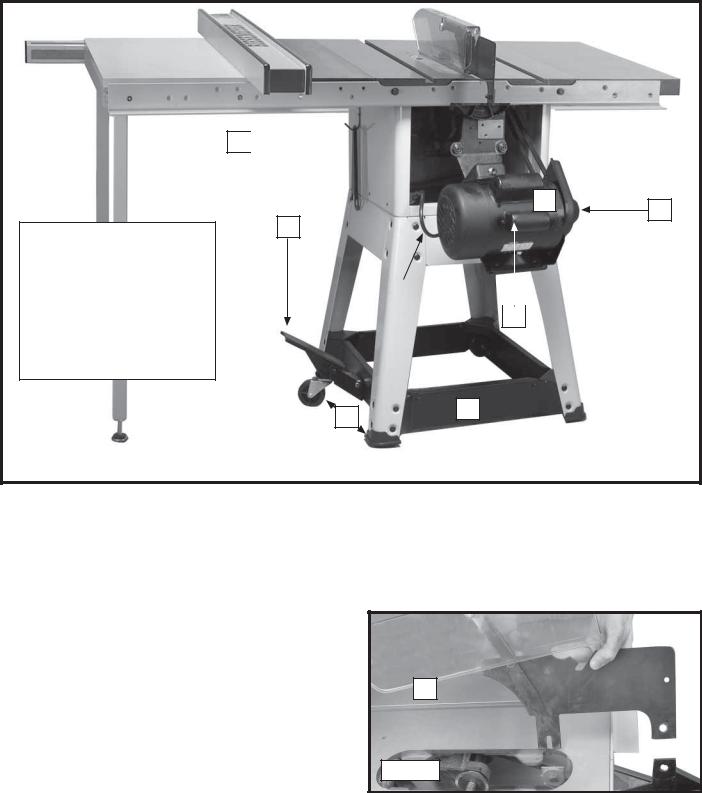
25 

19
18
24
BACK VIEW
18.Belt Guard
19.Motor
20. |
Overload Reset Button |
22 |
|
|
21. |
Mobile Base |
|
|
|
|
|
|
||
|
|
|
||
22. |
Motor Cord |
|
|
20 |
|
|
|
|
|
23.Leveling Feet
24.Mobile Base Foot Pedal
25.Blade Wrenches
21
23
BLADE GUARD AND SPLITTER USE
 The blade guard assembly provided with Delta saws (Fig. 63) must be used for all through-sawing operations. The splitter prevents the kerf from closing and binding the blade, causing kickback. The anti-kickback pawls
The blade guard assembly provided with Delta saws (Fig. 63) must be used for all through-sawing operations. The splitter prevents the kerf from closing and binding the blade, causing kickback. The anti-kickback pawls
(A) Fig. 62 prevent the workpiece and the cut-off piece from being thrown back at the operator. The plastic guard prevents dust and debris from being thrown at the operator. To use the guard properly:
1.Make sure that the splitter is aligned with the blade as described in the section “BLADE GUARD AND
SPLITTER ASSEMBLY AND ALIGNMENT.”
2.Replace or sharpen the anti-kickback pawls when they become dull.
3.Keep the guard clean for visibility and free motion.
4.Do not use solvent or lubricants on the guard. They may severely damage the plastic.
5.Use caution when feeding workpieces that may catch on the guard and cause a bind, or force the guard into the blade (such as when cutting moulding).
A
Fig. 63
24
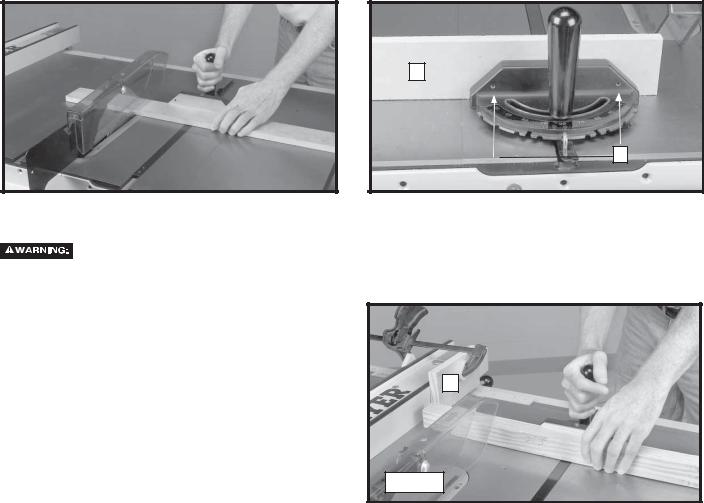
CROSS-CUTTING
Cross-cutting requires the use of the miter gauge to position and guide the work. Before starting the cut, raise the blade so that it is about 1/8” (3.2mm) higher than the top of the workpiece. Place the work against the miter gauge and advance both the gauge and work toward the saw blade (Fig. 64). You can use the miter gauge in either table slot. Start the cut slowly and hold the work firmly against the miter gauge and the table. Keep both hands on the miter gauge and workpiece. Do not touch the cut-off piece. Feed the workpiece steadily through the blade until the workpiece is completely cut. Shift the workpiece slightly sideways away from the blade, then pull the workpiece and miter gauge back to the starting position. Remove the workpiece, then use a push stick to push the cut-off piece past the blade and off the table before beginning the next cut.
For added safety and convenience, you can attach an auxiliary wood-facing (C) Fig. 65 to the miter gauge. This facing should be at least 1" higher than the maximum depth of cut, and should extend out 12" or more to one side or the other depending on which miter gauge slot is used. Attach this auxiliary wood-facing (C) to the front of the miter gauge by using two wood screws (A) through the holes provided in the miter gauge body.
C
 A
A
Fig. 64 |
|
Fig. 65 |
Never use the fence as a cut-off gauge when cross-cutting.
When cross-cutting a number of pieces to the same length, clamp a block of wood (B) to the fence and use it as a cutoff gauge (Fig. 66). The block (B) must be at least 3/4" thick to prevent the cut-off piece from binding between the blade and the fence during removal from the saw table. Always position this block of wood in front of the saw blade. Once the cut-off length is determined, lock the fence and use the miter gauge to feed the work into the cut.
C
Fig. 66
 When using the block (B) Fig. 66 as a cut-off gauge, position the rear end of the block so that the workpiece is clear of the block before it enters the blade.
When using the block (B) Fig. 66 as a cut-off gauge, position the rear end of the block so that the workpiece is clear of the block before it enters the blade.
25

MITERING
Mitering (Fig. 67) is the same as crosscutting except the miter gauge (C) is locked at an angle other than 0°. Hold the workpiece firmly against the miter gauge and feed the work slowly into the blade to prevent the workpiece from moving.
 Use caution when starting the cut to prevent binding of the guard against the workpiece. Miter angles greater than 45° may force the guard into the saw blade and damage the guard. Before starting the motor, test the operation by feeding the workpiece into the guard. If the guard contacts the blade, place the workpiece under the guard, not touching the blade, before starting the motor. Certain workpiece shapes, such as mouldings, may not lift the guard properly. Feed the work slowly to start the cut.
Use caution when starting the cut to prevent binding of the guard against the workpiece. Miter angles greater than 45° may force the guard into the saw blade and damage the guard. Before starting the motor, test the operation by feeding the workpiece into the guard. If the guard contacts the blade, place the workpiece under the guard, not touching the blade, before starting the motor. Certain workpiece shapes, such as mouldings, may not lift the guard properly. Feed the work slowly to start the cut.
C
Fig. 67
BEVEL CROSSCUTTING
Bevel crosscutting (Fig.68) is the same as crosscutting except the bevel angle is set to an angle other than 0°.
 When possible, use the right miter gauge slot when bevel crosscutting so that the blade tilts away from the miter gauge and your hands.
When possible, use the right miter gauge slot when bevel crosscutting so that the blade tilts away from the miter gauge and your hands.
Use caution when starting the cut to prevent binding of the guard against the workpiece.
COMPOUND MITERING
Compound Mitering (Fig. 69) is a combination of bevel crosscutting and mitering, where the blade is beveled to an angle other than 0° and the miter gauge is locked at an angle other than 0 degrees. Always use the miter slot (D) which allows the blade to tilt away from the miter gauge and hands.

 D
D
Fig. 68 |
|
Fig. 69 |
RIPPING
Ripping (Fig. 70) is cutting lengthwise through a board. The rip fence (A) is used to position and guide the work. One edge of the work rides against the rip fence while the flat side of the board rests on the table.
 You must use the saw blade guard. On Delta saws, the guard has anti-kickback pawls to prevent kickback, and a splitter to prevent the wood kerf from closing and binding the blade. Be sure to replace or sharpen the anti-kickback devices when the points become dull.
You must use the saw blade guard. On Delta saws, the guard has anti-kickback pawls to prevent kickback, and a splitter to prevent the wood kerf from closing and binding the blade. Be sure to replace or sharpen the anti-kickback devices when the points become dull.
 Always use a rip fence for ripping operations. NEVER perform a ripping operation free-hand. Always lock the fence to the rail.
Always use a rip fence for ripping operations. NEVER perform a ripping operation free-hand. Always lock the fence to the rail.
The workpiece must have a straight edge against the fence, and must not be warped, twisted or bowed.
26
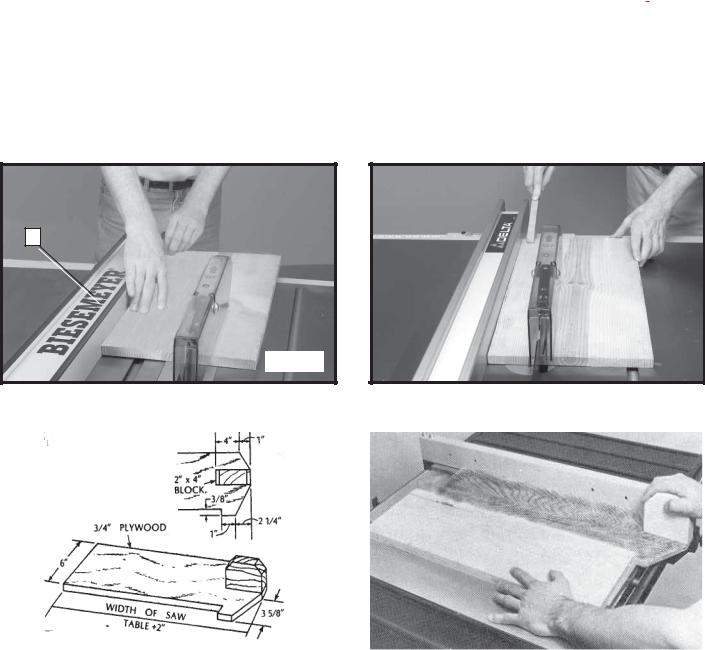
1.Before starting the cut, raise the blade so that it is about 1/8” (3.2mm) higher than the top of the workpiece. Start the motor and advance the work, holding it down and against the fence. Never stand in the line of the saw cut when ripping. When the rip width is 6 inches or wider, hold the work with both hands and push it along the fence and into the saw blade (Fig. 70). Feed force when ripping should always be applied between the saw blade and the fence. Never pull the workpiece from the back of the saw. The work should then be fed through the saw blade with the right hand. Keep pressure on the workpiece against the fence and down on the saw table. Ensure that you have adequate outfeed support for the workpiece and KEEP YOUR HANDS AWAY FROM THE SAW BLADE.
2.When the workpiece is past the blade, the work will either stay on the table or tilt up slightly and be caught by the end of the guard. Alternately, the feed will continue to the end of the table, and be lifted and brought along the outside edge of the fence. When ripping boards longer than three feet, use a work support at the rear of the saw to keep the workpiece from falling off the saw table.
3.If the size or shape of the workpiece would cause your hands to be within six inches of the saw blade, use a push stick to complete the cut (Fig. 71) The push stick can easily be made from scrap material as explained in the section
“CONSTRUCTING A PUSH STICK.””
4.Ripping narrow pieces can be dangerous. If possible, rip the narrow piece from the larger piece. If the workpiece is short enough, use a pushboard. (A pushboard can be constructed as shown in Fig. 72 and used as shown in Fig. 73.)
NOTE: In Fig. 73, the guard and splitter have been removed for clarity. Use the guard and splitter when ripping.
5.For longer pieces, use one or more pushsticks to avoid placing your hands between the fence and the blade. Always use care to avoid binding narrow strips between the anti-kickback pawls and the splitter.
NOTE: Some special operations (moulding cutterhead, etc.) require the addition of an auxiliary wood facing to the fence, as explained in the section “USING AUXILIARY WOOD FACING,” and use of a push stick.
A
Fig. 70 |
|
Fig. 71 |
|
|
|
|
|
|
|
|
Fig. 72 |
|
|
|
Fig. 73 |
|
|
|
|
|
|
|
|
|
|
|
|
|
|
|
27
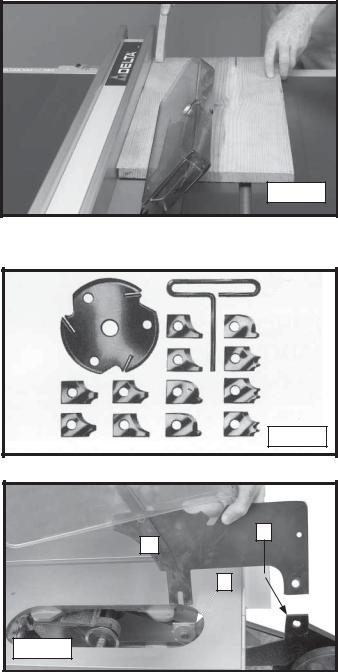
BEVEL RIPPING
Bevel ripping (Fig. 74) is the same as ripping except the bevel angle is set to an angle other than 0°.
 When possible, place the fence on the right side of the blade so that the blade is tilted away from the fence and hands. keep your hands clear of the blade and use a pushstick to feed the workpiece if there is less than 6” between the fence and the blade.
When possible, place the fence on the right side of the blade so that the blade is tilted away from the fence and hands. keep your hands clear of the blade and use a pushstick to feed the workpiece if there is less than 6” between the fence and the blade.
 Use caution when starting the cut to prevent binding of the guard against the workpiece.
Use caution when starting the cut to prevent binding of the guard against the workpiece.
USING A MOULDING CUTTERHEAD
Moulding is cutting a shape on the edge or face of the workpiece with a special moulding cutterhead.
The moulding head consists of a cutterhead in which can be mounted various shapes of steel knives (Fig. 75). Each of the three knives in a set is fitted into a groove in the cutterhead and securely clamped with a screw. Keep the knife grooves free of sawdust to allow the cutter to seating properly.
 For certain cutting operations (dadoing and moulding) where the workpiece is not cut completely through, the blade guard and splitter assembly cannot be used. Loosen screws at (G) and (H) Fig. 76. Lift and remove the blade guard and splitter assembly (W).
For certain cutting operations (dadoing and moulding) where the workpiece is not cut completely through, the blade guard and splitter assembly cannot be used. Loosen screws at (G) and (H) Fig. 76. Lift and remove the blade guard and splitter assembly (W).
 Use pushsticks, hold-downs, jigs, fixtures, or featherboards to help guide and control the workpiece when the guard cannot be used.
Use pushsticks, hold-downs, jigs, fixtures, or featherboards to help guide and control the workpiece when the guard cannot be used.
Fig. 74
Fig. 75
G
W
H
Fig. 76
NOTE: The outside arbor flange cannot be used with the moulding cutterhead. Tighten the arbor nut against the cutterhead body. Do not lose the outside arbor flange. It will be needed when reattaching a blade to the arbor.
 Always return and fasten the blade guard and splitter assembly to its proper operating position for normal thru-sawing operations.
Always return and fasten the blade guard and splitter assembly to its proper operating position for normal thru-sawing operations.
28
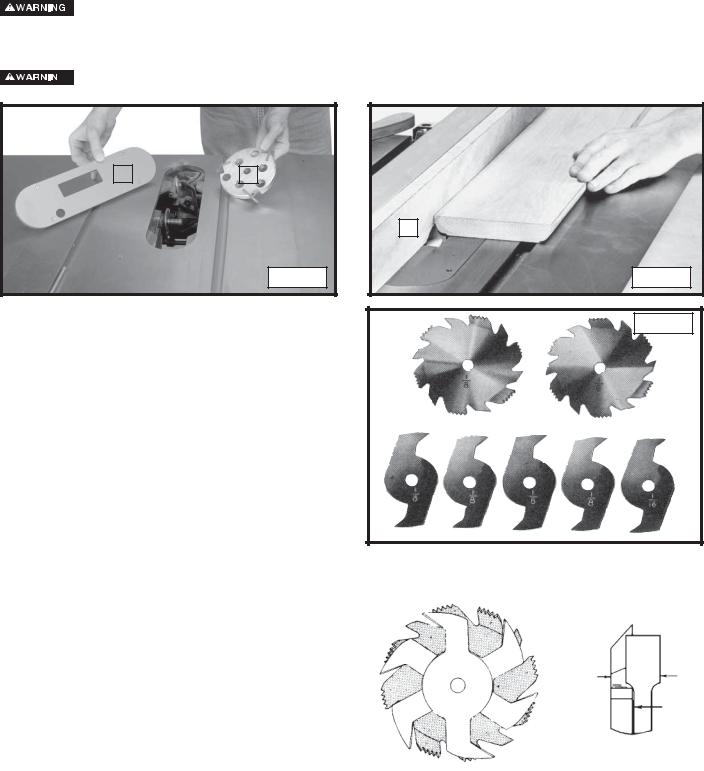
1.You can easily attach a moulding cutterhead (A) Fig. 77 to the saw arbor. Also, you must use the accessory moulding cutterhead table insert (B) in place of the standard table insert.
2.When using the moulding cutterhead, add wood-facing (C) to the face of the rip fence (Fig. 78). The wood-facing is attached to the fence with wood screws through holes which must be drilled in the fence. Stock that is 3/4" inch thick is suitable for most work, although an occasional job may require 1" facing.
3.Position the wood-facing over the cutterhead with the cutterhead below the surface of the table. Turn the saw on and raise the cutterhead. The cutterhead will cut its own groove in the wood-facing. Fig. 78 shows a typical moulding operation.
 Never use a moulding cutterhead in a bevel position.
Never use a moulding cutterhead in a bevel position.
 Never run the stock between the fence and the moulding cutterhead. Irregular-shaped wood will cause
Never run the stock between the fence and the moulding cutterhead. Irregular-shaped wood will cause
kickback.
 Give special attention to the grain direction. Make all cuts in the same direction as the grain whenever possible.
Give special attention to the grain direction. Make all cuts in the same direction as the grain whenever possible.
 Always install the blade guard after the operation is complete.
Always install the blade guard after the operation is complete.
B |
|
A |
Fig. 77
USING AN ACCESSORY DADO HEAD
 The blade guard and splitter assembly cannot be used when dadoing or moulding. It must be removed as described in “USING AN ACCESSORY MOULDING CUTTERHEAD” section.
The blade guard and splitter assembly cannot be used when dadoing or moulding. It must be removed as described in “USING AN ACCESSORY MOULDING CUTTERHEAD” section.
 Use pushsticks, hold-downs, jigs, fixtures, or featherboards to help guide and control the workpiece when the guard cannot be used.
Use pushsticks, hold-downs, jigs, fixtures, or featherboards to help guide and control the workpiece when the guard cannot be used.
 The accessory dado head set table insert (B) Fig. 77 must be used in place of the standard table insert.
The accessory dado head set table insert (B) Fig. 77 must be used in place of the standard table insert.
Dadoing is cutting a rabbet or wide groove into the workpiece. Most dado head sets are made up of two outside saws and four or five inside cutters, (Fig. 80). Various combinations of saws and cutters are used to cut grooves from 1/8" to 13/16" for use in shelving, making joints, tenoning, grooving, etc. The cutters are heavily swaged and must be arranged so that the teeth do not hit each other during rotation. The heavy portion of the cutters should fall in the gullets of the outside saws (Fig. 80). The saw and cutter overlap is shown in Fig. 81 - (A) being the outside saw, (B) an inside cutter, and (C) a paper washer or washers, used as needed to control the exact width of groove. A 1/4"groove is cut by using the two outside saws. Position the teeth of the saws so that the raker on one saw is beside the cutting teeth on the other saw.
C
Fig. 78
Fig. 79
|
|
|
|
A |
|
B |
|
|
|
|
|
|
C |
|
|
|
|
|
|
|
|
Fig. 80 |
|
|
|
Fig. 81 |
|
|
|
|
|
|
|
|
29

 Do not attempt to stack dado blades thicker than 13/16” (20mm) Do not use dado blades larger than 8” (200mm) in diameter.
Do not attempt to stack dado blades thicker than 13/16” (20mm) Do not use dado blades larger than 8” (200mm) in diameter.
Attach the dado head set (D) Fig. 82 to the saw arbor.
NOTE: If the arbor nut does not fully engage the thread on the arbor, remove the outside arbor flange and tighten the arbor nut against the dado head set body. Do not lose the outside arbor flange. It will be needed when reattaching a blade to the arbor.
 Never use the dado head in a bevel position.
Never use the dado head in a bevel position.
Always install the blade guard and standard table insert after the operation is complete.
D
E
|
|
Fig. 83 |
Fig. 82 |
|
|
|
|
|
A typical dado operation is illustrated in Fig. 83.
USING AUXILIARY WOOD FACING
Add a wood facing (A) Fig. 84 to one or both sides of the rip fence when you perform special operations (moulding cutterhead, etc.). Depending on the fence, attach the wood facing or the fence either with wood screws through holes drilled in the fence, or with two clamps. For most work, 3/4” stock is suitable, although an occasional job may require 1” facing.
A
Fig. 84
30
